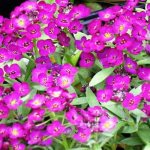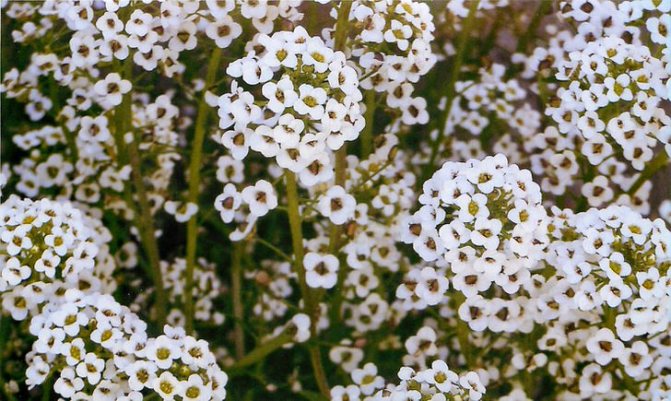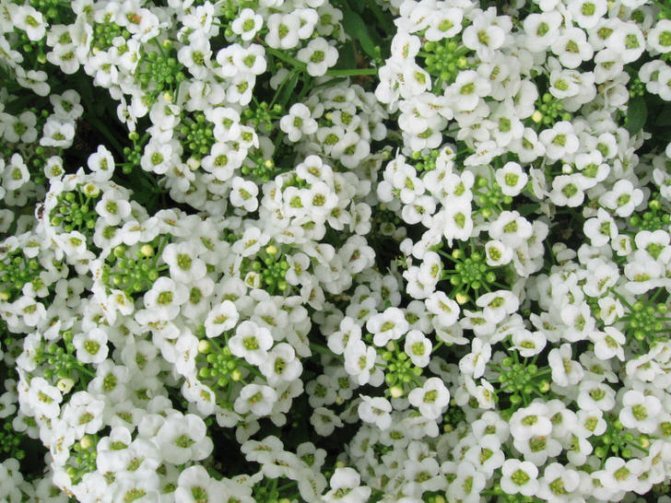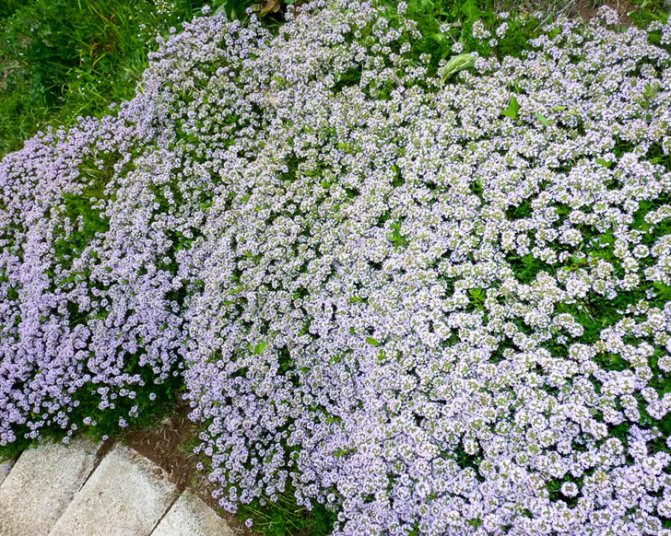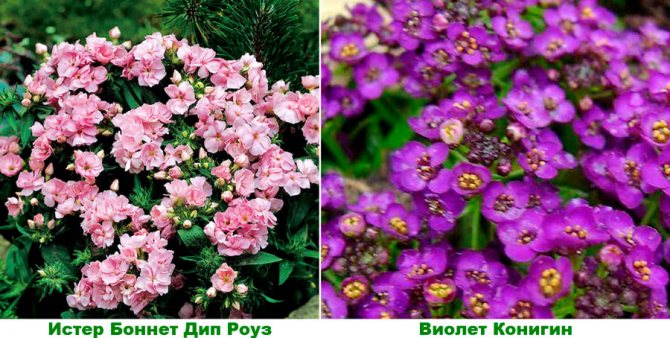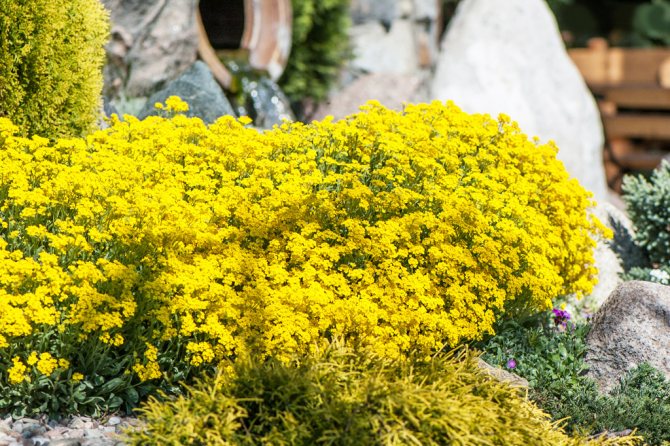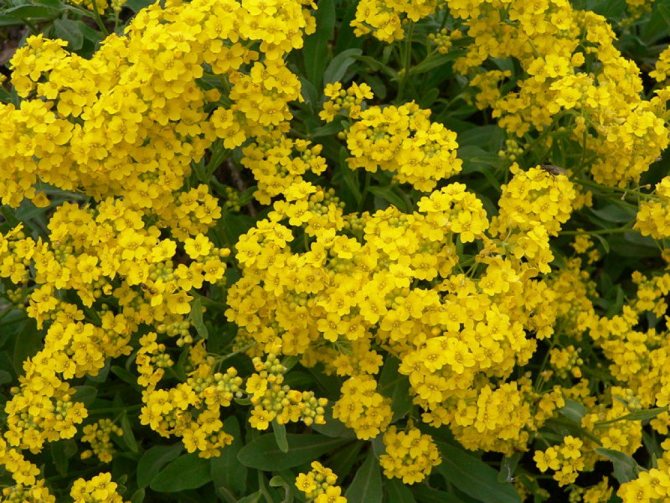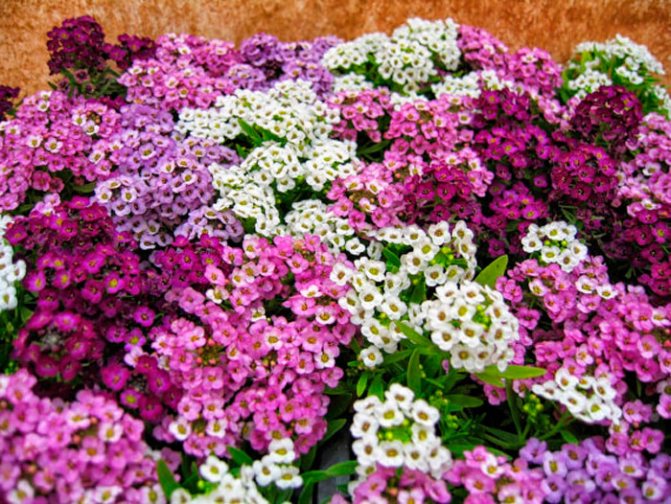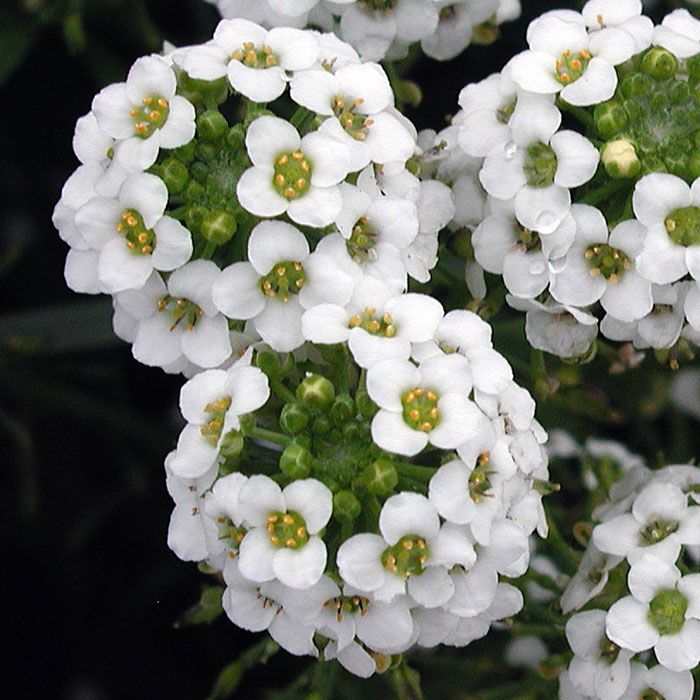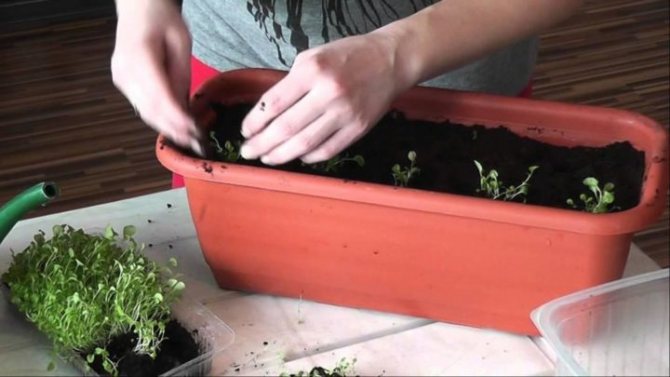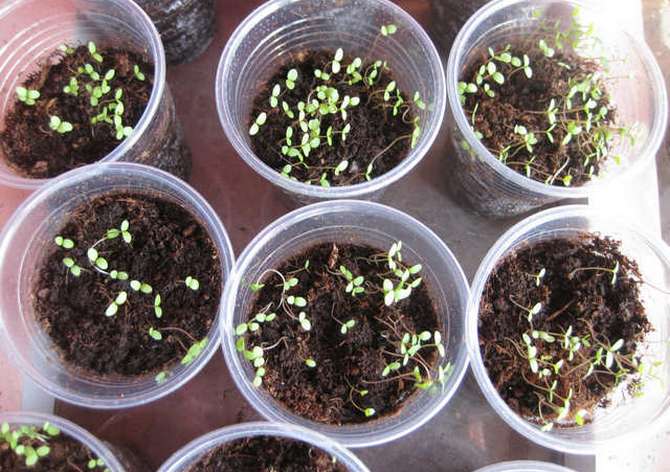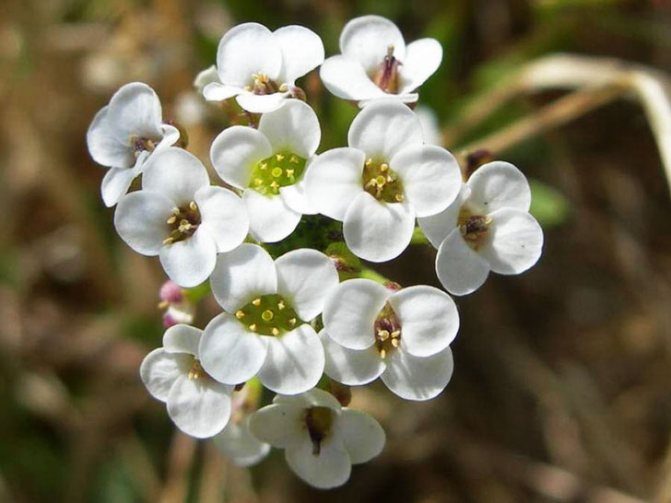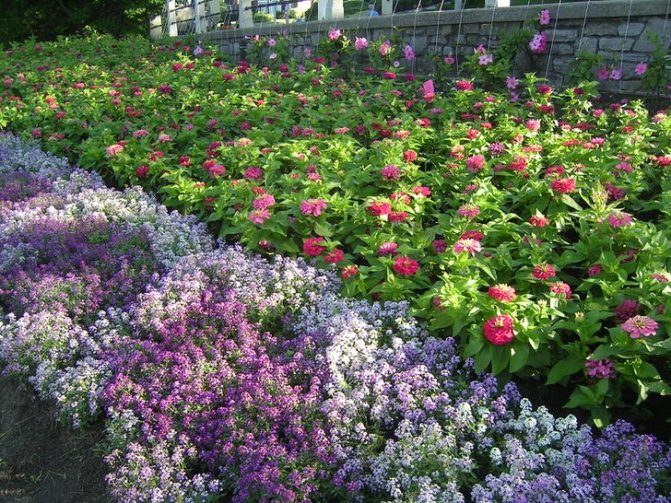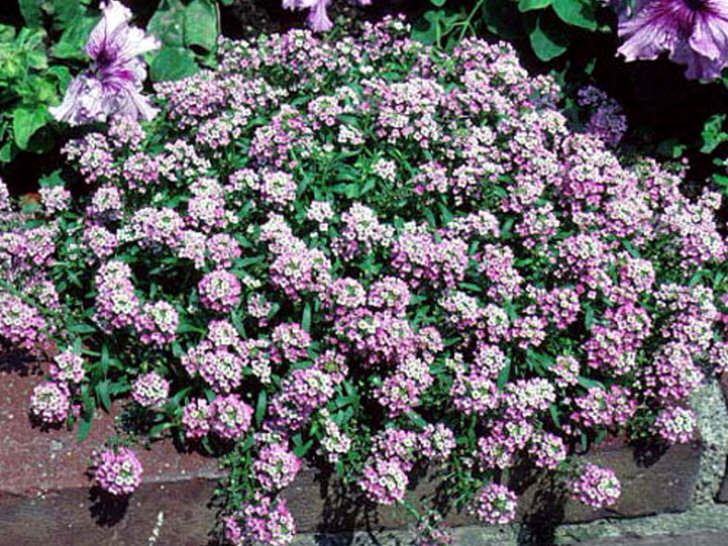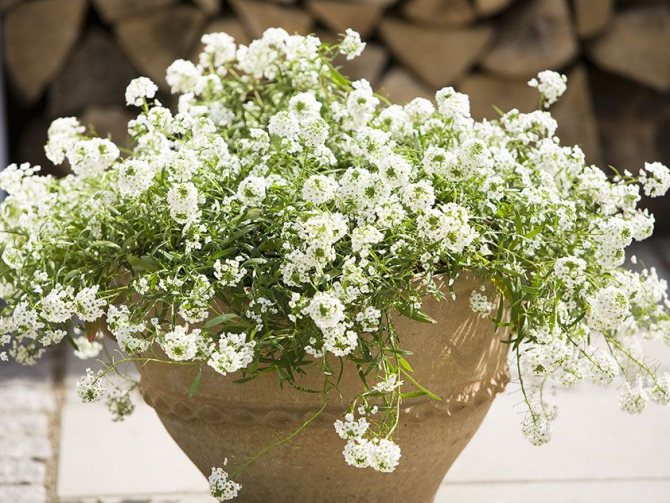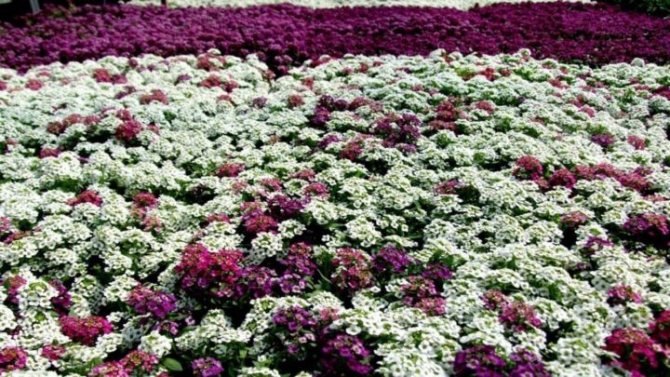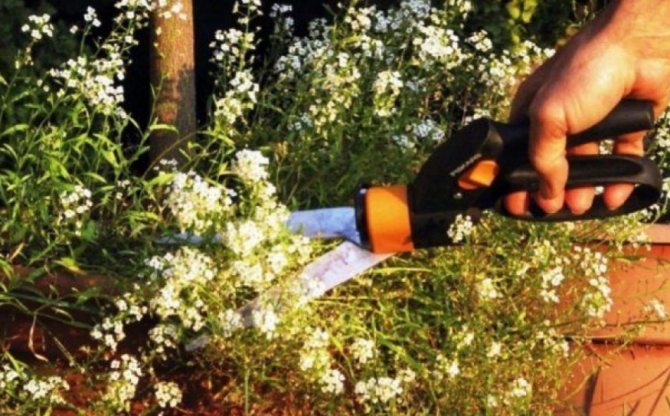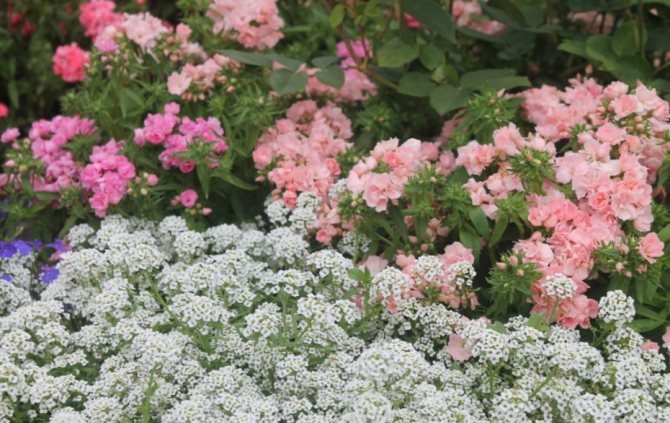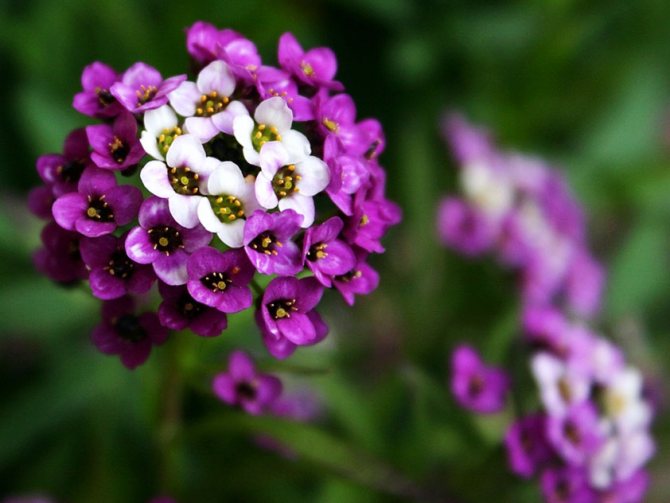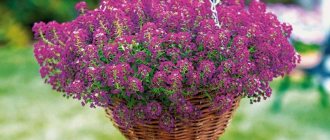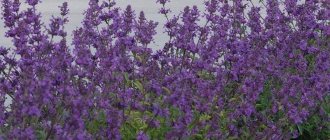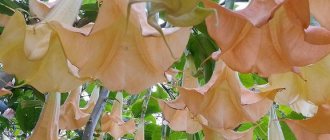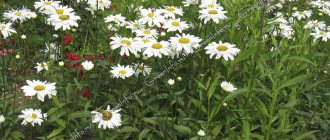Alyssum (Alyssum), also called sea lobularia, or beetroot, is a genus that is part of the Cabbage family (formerly Crucifers). This genus includes about 100 different species. In nature, such plants can be found in Asia, North Africa and Europe. The word "alissum" itself is a Latinization of the Greek word "alisson", where "a" is translated as "without" (negation), and "lyssa" means "canine rabies." There is an assumption that this plant was used in antiquity in the treatment of rabies in dogs. Gardeners began to cultivate alyssum relatively recently, but it is becoming more and more popular from year to year. This is due to the fact that the flower is very easy to care for, and it also has a very strong honey scent.
Alyssum flowers - description, photo
Enchanting representatives of the flora have joined the top ten of the most fragrant plants, the smell of which is associated with honey aromas and spreads within a radius of 10 meters from the planting site, and the most fragrant is "Alyssum Fragrant". Plants belong to the Cruciferous family of annual and perennial species, among which there are both herbal and artisanal varieties.
All species are angiosperms and dicotyledons, the buds of which are used as seed propagation. The seeds are distinguished by two lobes, and the ovules - by the presence of a protective capsule closed on all sides. The buds of flora representatives are made of 4 petals and 4 sepals arranged crosswise. The flowers are equipped with 6 stamens and a pistil, which allows some species to self-pollinate.
The flower-depleting scent attracts a variety of insects, including bees, which puts Lobularia on a par with the best honey representatives.
Cruciferous plants are distinguished by small structural details, regardless of whether it is a shrub or grassy species. The buds are rather small in size, but due to the combination into inflorescences, they become very noticeable. They are often done in bright yellow or white tones. The leaves are colored in dark tones with a slight tint of gray.
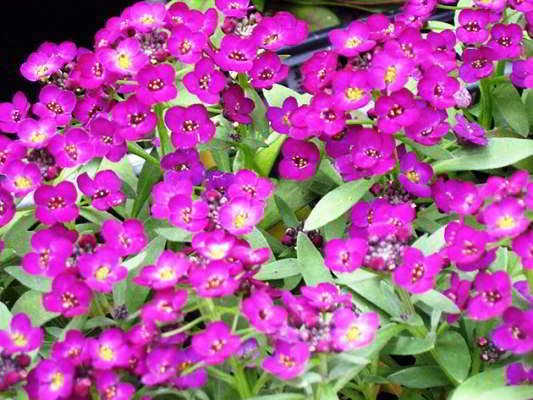
After pollination, most of the plants lose their decorative appearance, since they are characterized by a quick fall of petals and residues on the stems of "brooms" in the form of small stamens. So that the flowers do not lose their showiness after pollination, they are often grown in large groups, avoiding single plantings.
Alyssum - perennial flowers for the garden
The alyssum flower is native to Asia, North Africa and Europe. Translated from Greek, their name means "canine rabies." There is a version that this plant was used to treat rabies in dogs. Flowers have recently been used in horticulture. However, they are gaining more and more popularity for their ease of care and a pleasant honey scent.
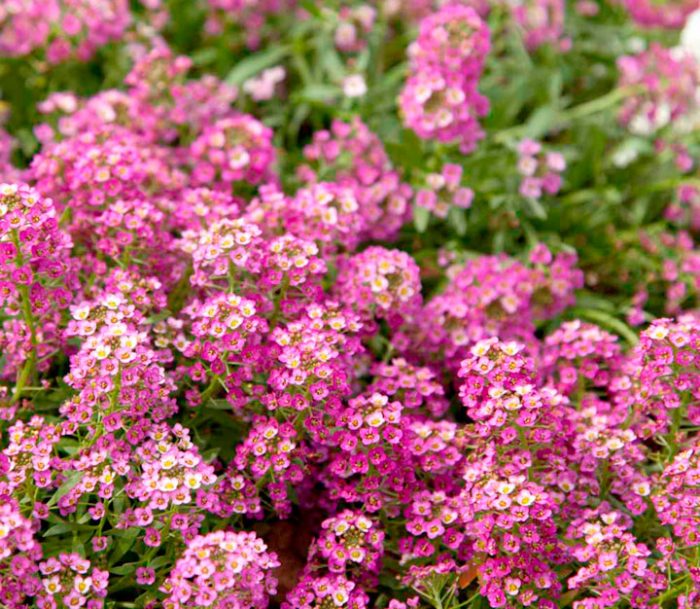

What does alyssum look like
One year old alissum
Alyssum annual blooms beautifully and can perfectly complement other flowers in the flower bed. It begins to bloom in June and lasts until late autumn. The shades are white, pink and purple.
Annual varieties:
- Queen: small lilac-purple flowers.
- Snow carpet: small white flowers.
- Popular hybrids with raspberry, blue and lilac petals: Violet Queen, Esther Bonnet Deep Rose, Tiny Tim.
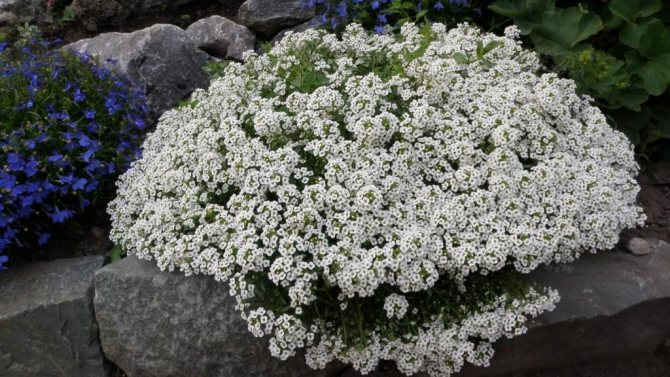

Annual flower "Snow Carpet"
Description of the flower of the plant alissum
The buds are composed of four petals and four sepals. Their arrangement is criss-cross. The plant exudes a strong honey scent, which is why it is highly attractive to bees. These flowers are among the best honey plants.
All parts of alyssum are small in size: leaves and buds. They can be seen due to the fact that the buds are collected in inflorescences. Most often, the color of the buds is yellow or snow-white. The leaves are dark with a grayish tint.
Important! In the landscape, alyssum flowers are often grown in a flowerbed in the form of a carpet.
Before picking up color, leaves begin to turn green and grow. They are small in size and have a grayish color. Their shape is oblong and obovate. Above, there is a slight pubescence.
When does alyssum bloom? It does not matter whether a perennial or an annual alyssum is grown - it blooms anyway from June. At the same time, flowering continues until late autumn.
Types and varieties of alissum
The varieties of this fragrant plant number about a hundred units, including annual and perennial varieties. Let's consider the most popular ones, and let's start with "Alyssum of the Sea", also known as "Lobularia of the Sea". The natural halo of flowers is the territory of the Mediterranean, in Russia it is more often cultivated in mid-latitudes. The flowering of the species begins in May days, ending with the onset of the first autumn frosts. Plants are characterized by active growth and tolerate decorative haircuts. There are several garden varieties:
- "Bentama" - with white flowers of large sizes, grow to 35-40 cm. Breeders have derived several sub-varieties from the named variety: "Weiss Risen", "Shneeshturm" and some others.
- "Rocky" - a perennial native to Europe and Asia, grows up to 35 cm. It differs in the original form of leaves in large numbers with a predominance of juicy gray blotches. Leaves on stems tend to persist in winter. The buds are collected in panicles, painted in a yellow tone. Flowering is early and fairly short, beginning in April and ending in May. Some of the varieties in this variety are Compactum, Plenum, Procumbes, Dudley Neville, Citrinum and Golden Wave.
- "Pyrenean" - originally from the French mountains, grows up to 20 cm. Leaves are oval, dense structure with a silvery sheen, slightly fluffed. The buds are painted in white tones, flowering occurs in the summer.
- "Creeping" - a natural habitat eagle belongs to the steppe and mountain landscapes of the East and South-East of Europe, as well as the Western part of Asia. It grows from 45 to 60 cm. The leaves are oval at the roots, collected in a rosette. The leaves on the stems are pointed, the petals are painted in bright yellow tones, flowering occurs on May days.
- "Silver" is a perennial growing up to 85 cm. Stems are rosettes of silvery-green shades. The leaves are small, painted in gray-silver tones at the bottom, green at the top. Lemon-colored petals, flowering begins in May, ends in July.
- "Alpine" - originally from the highlands of Europe, grows only up to 7 cm. Short stems form the form of bundles, gray leaves have an elliptical shape, yellow petals are collected in inflorescences in the shape of a ball.
- "Borage" - perennial with a tree-like root system grows up to 40 cm, stems at the base of the tree species. The leaves are inversely lanceolate at the bottom, noticeably narrowed at the top. Small flowers, growing up to 0.5 cm in length.
- "Borzi" - with a woody root system and numerous stems, which are covered with white hairs. The leaves taper towards the base, and their appearance deteriorates during the flowering period. The petals are colored yellow.
- "Cup" - herbaceous annual, growing from 20 to 30 cm. The roots are pale, made in the shape of a spindle. Stems are straight, branched below. Leaves are short petiolate, elongated, gray shades. Inflorescences are tassels on low legs. Flowering begins in June and ends in September.
- "Wedge-leaved" is a small herbaceous annual growing up to 15 cm. The leaves are spatulate-oblong, narrowed at the base. The flowers have oblong sepals with yellow petals, collected in a brush. The presence of fruits with a diameter of 0.5 cm is characteristic.
- "Dagestansky" is a perennial growing up to 25 cm. Stems with dense foliage, flowers of a fawn tone do not exceed 1 cm in diameter.
- "Desert" - an annual species, growing from 4 to 22 cm. Stems branch closer to the base, the leaves are oblong, narrowed at the base. Flowers are collected in clusters, which elongate somewhat during fruit ripening.
- "Gmelin" is a perennial of green-gray scale, grows from 6 to 22 cm. The root tends to grow stiff, the stalk is lying, strongly branching, the shoots are short. The petals are colored in rich yellow shades, reaching 5-7 mm in diameter.
- "Mountain" - perennial, growing from 5 to 30 cm, covered with star-shaped villi, is distinguished by a thin, woody root system. Branched stem with short shoots. At the bottom, the leaves are inversely lanceolate, longitudinal at the top, covered with infrequent villi. Flowers are collected in simple panicles, sepals are covered with a thick layer of stellate villi. The petals are golden yellow, flowering begins in April and ends in June.
- "Inversely ovate" - lives mainly in the West and East of Siberia, in Central Asia and the steppes of Mongolia. Roots are distinguished by easy removal of their soil, stems at the base of a tree species. It grows from 15 to 20 cm, it has a branched top. The inflorescences are very dense, made in the form of tassels, the petals are painted in a yellow tone. The fruits do not exceed 0.5 cm in length.
- "Thorny" - semi-shrub species, rather loose, prickly, grows from 40 to 50 cm. Leaves are oval, silvery tones. The petals are painted white, gathered in short tassels. It has a strong aroma, flowering in May.
- "Sinuous" or "Curved" - perennial with a woody stalk at the base, grows from 8 to 30 cm. Leaves are inverse oval-oblong, oblong or oval-rounded, small in size, narrowed near the base, look gray from the presence of a cannon. Inflorescences branch, in shape - corymbose-paniculate. The flowering period begins in April and ends in June.
Alyssum: perennial or annual, features and popular species, video
Among the undersized flowering plants, it is worth highlighting alyssum - compact lush bushes up to 40 cm high, which branch strongly. It belongs to the cruciferous family and is often used as a groundcover. Growing rapidly and releasing their long semi-lignified shoots in different directions, the bushes form a beautiful carpet of small long leaves and small flowers. Alyssum blooms throughout the spring, spreading a delicate aroma around. The color of the inflorescences in the form of panicles can be very diverse: from pale white to deep purple.
Growing alissum from seeds
The multicolored fragrant bushes are easy to grow from seeds, observing the sowing time and other nuances to ensure successful germination and development. The seed method is not only very economical, but is practically the only one suitable for cultivation.
When to sow seeds?
Sowing begins in the third decade of March and the first decade of April, which will allow lobularia to smell in May, since from the moment of planting to the first flowering, it takes from 1 to 1.5 months. It is advisable to adhere to lunar cycles and sow during the waxing moon.
Sowing alyssum
For the emergence of fast and synchronous shoots, it is recommended to sow in containers of medium depth, which are covered with a film for the first few days to create a vacuum. The seed is spread over the soil surface and lightly pressed down or covered with a thin layer of earth.
Remember that seeds need good lighting for germination, strong dusting can delay vegetation.
The seedlings must be periodically ventilated and the accumulated condensate removed; as they germinate, they get rid of the shelter. As a container, plastic containers equipped with a removable lid are well suited. In addition, it is easy to make holes in them along the bottom to ensure the outflow of excess moisture.
Alyssum seedlings care
It is important to provide the lobularians with excellent illumination. In early spring, they may need an extra source of daylight. As the first leaves appear, it is necessary to feed from a complex fertilizer. Picking into separate small containers is carried out as 3 leaves are formed. Seedlings need moderate watering, it is advisable not to expose them to direct sunlight in order to avoid burns.
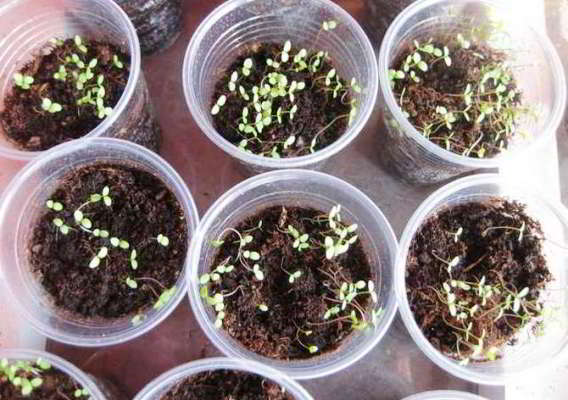

Features of lobularia
- A low-growing ground cover flower grows up to 15-40cm high.
- Stems strongly branching at the base are semi-lignified. The leaf plates are small, oblong, with pubescence on the surface.
- Inflorescences are racemose small. Small flowers can be yellow, pink, purple, white, lilac or red.
- It begins to bloom in May and continues until late autumn.
- The pod is the fruit within which the seeds ripen.
- The seeds can be stored for 3 years.
- An excellent honey plant with a spicy honey scent.
Important! Alyssum and sea lobularia are different plants, but the closest relatives. They are very similar to each other, so gardeners refer them to the same genus. In lobularia, flowers are lilac, white or pink, in alyssum, they are yellow or beige.
Alyssum is grown as a perennial or annual in flower beds, in flower beds and pots. It is often planted in areas that are empty after the spring bulbous plants have faded.
Planting alyssum in the garden
Well-lit places are selected for planting, since in partial shade the flowering will be uneven and rather loose. The soil should be fertile, light or neutral in composition. Be sure to think over a drainage system to help lobularians get rid of excessive moisture and not destroy the roots.
In the case of abundant feeding, foliage develops strongly, reducing the formation of buds. They grow well in the location between stones or slabs, which are well warmed up in the sun.
When to plant alissum
The landing occurs in the third decade of May or early June, when the threat of a decrease in night temperatures has finally passed. In this case, the seedlings will take root safely and will soon delight gardeners with wonderful aromas.
How to plant alissum
Seedlings are sent to open ground, be sure to take into account their abundant growth in the future. It is recommended to maintain a distance between seedlings of at least 40 cm, depending on the variety. The depth of the holes should be equal to the size of the roots with a lump of earth from the growing container; it is not necessary to deeply deepen the seedlings. After the end of the transplant, the seedlings are moderately moisturized.
In the case of seed planting in open ground, flowering will begin on average 6 weeks after germination.
Alyssum - care
Crucifers are a pleasure to grow because they don't require much gardener attention beyond weeding and watering. Regular moisture is especially needed during the period of active flowering in dry seasons. The root system is prone to decay, so it is important to be moderate and not flood the seedlings. Perennials need to provide fertilizing with mineral fertilizer, which is applied once in spring and autumn.
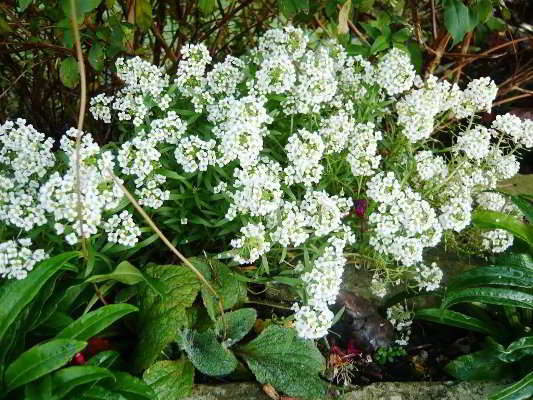

Annuals will need 4 feedings, the first of which is introduced during the development of stems and foliage. It is advisable to fertilize the seedlings with nitrogen-containing complexes.Subsequent dressings are applied monthly, changing the composition to phosphorus-potassium and nitrogen in equal proportions. Periodically, the soil needs to be loosened, weeds must be removed in a timely manner.
Timely and regular fertilization will ensure excellent flowering.
Alyssum care
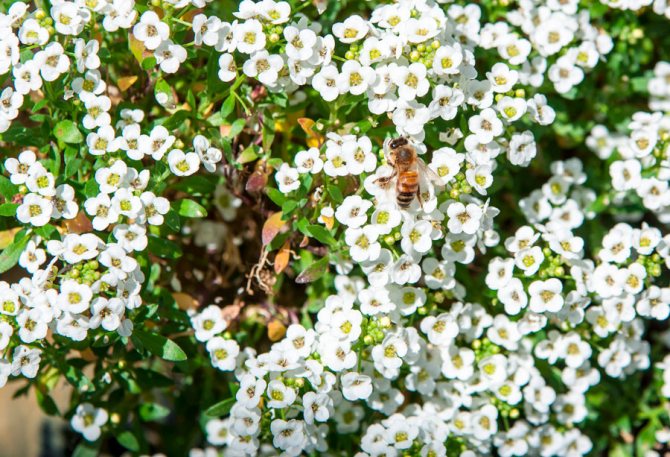

Alyssum grown in the garden is very easy to care for. Such a plant must be watered, weeded, fed, cut in a timely manner, and the surface of the soil should also be regularly loosened. Watering such a flower should be systematic, while watering should be abundant during a prolonged drought. It should be remembered that if the plant lacks moisture, then it can shed both the buds and the opened flowers. However, it is possible to water the plant abundantly only if the soil passes water well. If there is stagnation of liquid in the soil, then the bushes will get wet and die. To understand whether watering is required for Alyssum, you need to dig the soil to a depth of 30–40 mm with a shovel. If the soil there is dry, it means that these flowers must be watered. When watering is finished, it is recommended to remove all weeds from the site, and also to loosen its surface between the bushes. In order to significantly reduce the number of weeding and watering, in the spring after planting, the surface of the site should be sprinkled with a layer of mulch. But it should be borne in mind that even if the site is mulched, its surface still needs to be systematically loosened, since this procedure improves the air and water permeability of the soil, and therefore it is very important when growing this flower crop.
Alyssum, which is a perennial, must be fertilized during the growth of green mass; for this, fertilizers containing nitrogen are used. To prepare a nutrient solution for 1 bucket of water, take 1 large spoonful of urea and Agricola-7. Before flowering begins, the plant must be fed with complex fertilizer, which must be applied to the soil. Annuals need frequent feeding, so, during the season they are fed 4 times, while the first fertilization is done shortly before the alissum blooms. If you feed annuals correctly and on time, they will delight the gardener with lush flowering.
Pruning alyssum


In order for the alyssum to develop correctly and bloom magnificently, it must be pruned in a timely manner and correctly. In spring, it is necessary to cut off all dried foliage from perennials, peduncles left over from last year, as well as weak and diseased stems. When the summer flowering is over, it is necessary to repeat the pruning procedure, and then shorten all the stems by 50–80 mm, this will provoke repeated flowering. In addition, the bushes after pruning look more compact and well-groomed.
Diseases and pests


The cruciferous flea is the most dangerous for this culture, because it is quite difficult to get rid of it. The affected bushes should be sprayed with a solution of vinegar essence (1 large spoon for 1 bucket of water), however, only adults, sufficiently powerful specimens can withstand such treatment.
Caterpillars can also harm flowers. To get rid of them, alissums are sprayed with infusion of tobacco with soap or chamomile. Whites and cabbage moths can also harm the plant; to get rid of them, use lepidocide or entobacterin.
If the soil has insufficient water permeability, as well as with constant stagnation of liquid in the soil, the plant develops late blight (brown rot), which affects the root system and the root collar of the bush. It is recommended to spray the affected plant with copper oxychloride or fungicidal preparations (Thanos, Ordan or Kuproksat).
Also, the plant can get sick with downy mildew or powdery mildew, as well as a viral mosaic.To get rid of powdery mildew, the bush is sprayed with Topaz or Bordeaux mixture, and in the fight against downy mildew, Ordan, Oxykhom or Bordeaux liquid are used. The viral mosaic is currently not amenable to treatment.
How to grow alissum
Planting crucifers is an easy task, since the material is famous for its excellent germination and dynamic growth. To grow healthy and strong lobularia, the gardener needs to remember about moderate watering and not forget about loosening. In case of doubt about the moisture content of the soil, it is recommended to check it by digging to a depth of 4 cm: if it turns out to be dry there, then the flower can be safely watered.
By the way, if the land is mulched during spring planting, watering and weeding can be done much less often.
Color palette
In the wild, there are plant varieties that form lilac and white flowers, but for garden landscaping and growing on balconies, loggias and terraces, flower growers often prefer more decorative types:
- white, including Little Dorrit, Big Gem, Weiss Riesen, Primavera Princess and Snow Crystals;
- pink or purple, including Salmon and Royal Carpet varieties;
- pale lilac, purple and lilac, Easter Bonnet Deep Pink, Wonderland Blue, Variegatum and Oriental Night;
- yellow, Easter Bonnet Pastel Mixture and Compactum Gold Dust varieties.
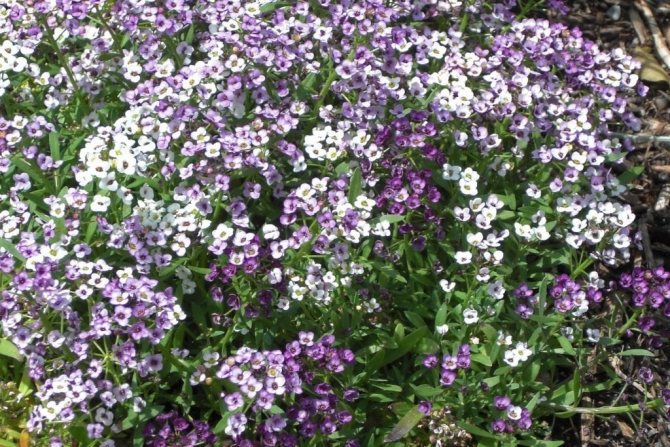

Multicolor varieties are especially popular, for example, Paletta, which combines several original colors.
Pests and diseases of alyssum
Plants are distinguished by high immunity against diseases and all sorts of pests. It is important to avoid planting on acidic soils, since the bushes will not be able to please with a compact look and lush color. Among rare pests for lobularia are dangerous:
- The cruciferous flea is a small insect that can only be eliminated by vinegar treatment or chemicals. The latter can be bought in specialized stores, and a homemade solution is prepared at the rate of 10 liters of water per 1 tablespoon of the essence. Both young and adult seedlings can be processed with such a potion.
- Belianka is a white butterfly whose larvae eat leaves. You can fight the pest with drugs like Entobacterin or Lepidocide.
- Caterpillars - it is recommended to fight the ubiquitous insects with a soap-tobacco solution or an infusion of chamomile petals.
Of the diseases, powdery mildew is terrible for lobularia, the appearance of which is provoked by shaded and damp areas. It is easy to get rid of the fungus with fungicides or preparations with a high copper content.
Flower arrangements with alissum
If you breed alissum in a seedling way, you have a great opportunity to form your own rock garden or rockery on the garden plot. This plant is ideal for creating compositions on stones.
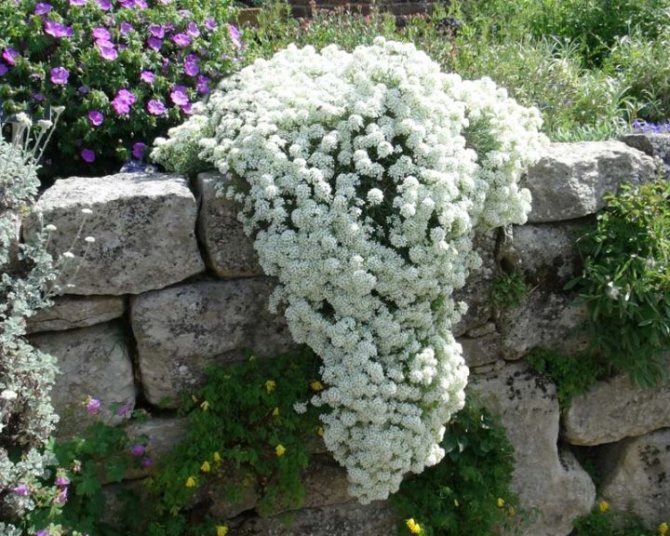

Registration of the site with the help of alissum
Alyssum looks great in cracks in masonry walls, in breaks in paving slabs, as well as between boulders and large fragments of stones. Tall varieties are good for border decoration. Ground cover plants can be placed around the edges of a flower bed with tall flowers and shrubs. Alyssum flowers look good next to viola (night violet) and forget-me-nots, they go well with carnation, pelargonium, levkoy, heliotrope. Alyssum is also good as an independent element of decor - its numerous flowers can create a unique living carpet with a wonderful aroma.
Despite the fact that alyssum is a plant for open ground, it can be successfully grown on the balcony. 3-4 bushes, planted in a pot, form a beautiful hat over time. The flower takes on the appearance of an ampelous flower - the shoots hang along the edges of the container and seem to envelop it in a multi-colored fragrant carpet. Watering and pruning is carried out as needed. The only negative is that the plant does not tolerate winter indoors. Therefore, when grown on a balcony, it must be planted every year.
How to prolong flowering
In order to achieve the longest and most continuous flowering period, it is necessary to arrange pruning with the complete removal of elongated, dried inflorescences. All shoots are shortened by 5 cm. Seasonal autumn and spring pruning is also carried out, which help gardeners to obtain abundant color for a long time.
Alyssum after flowering: how and when to collect alyssum seeds
Lobularia begins to collect seed in the third decade of September and in early October. It is advisable to choose a calm, dry weather in order to ensure complete collection and not lose seeds. On the garden plot or on the territory of the courtyard, you need to spread a towel or bedspread, on which to manually rub the inflorescences.
Upon completion, large husks are removed, the seed is thoroughly dried in a well-ventilated room, after which it is placed in bags made of natural fabric and sent to storage in a dark and dry place. In the case when the gardener was late with the collection of seeds and they had time to crumble, it is necessary to carefully sweep the seed material out from under the branches and select the necessary specimens.
Alyssum after flowering
Seed collection


You need to collect seeds in the last days of September or the first in October. Choose a dry day with no wind. It is necessary to spread the fabric directly on the ground, and then they take the inflorescences in their hands and carefully rub them. When you're done, remove any large debris, and leave the small ones. For drying, the seeds are placed in a dry room with very good ventilation, but there should be no drafts. Seeds should be poured into a cloth bag and stored until spring. If the seeds have already spilled out on the ground, then in this case it is necessary to carefully sweep them out with a broom from under the bushes. Once the debris has been removed, the seeds should be stored in the same way as described above.
Perennial wintering
Alyssum has an average winter hardiness, so if the air temperature drops less than minus 15 degrees, the plant will die. However, in regions with fairly mild winters, this flower, if properly prepared, can survive the colder months. In late autumn, the site should be covered with dried foliage. After the snow falls, a snowdrift should be thrown over the foliage. If you cover the alissums in this way, they will be able to survive the winter, while the green foliage will remain on the bush. It is not recommended to prune the plant before winter; a haircut is arranged in spring.
The specifics of sowing alyssum seeds in open ground
Sowing in open ground is possible only with the onset of warm days, which will completely exclude night frosts. The first or second decade of May will be a favorable time, it is not recommended to sow earlier, since there is a high probability of non-germination of the material, with the exception of greenhouse sowing.
It is very important to choose the optimal area with excellent illumination and in a place protected from drafts.
Preparation of the soil begins a month before the intended planting, flavored with humus or compost. They also arrange good drainage from expanded clay, sand or small pebbles, followed by digging. The prepared areas are leveled, shallow grooves are made and the seed is distributed.
Beauty in the country and in the garden: how to grow perennial alissum
Do you want to make your garden or summer cottage unique? Plant a perennial alissum in it. This flower is unpretentious to climatic conditions, easy to grow and does not require special care. Its decorativeness has long been appreciated by lovers of original landscape design. It is customary to decorate borders with alissum bushes, arrange flowers along the terrace or walls of the house, it looks very beautiful in a separate flower bed. Its delicate fragrant flowers adorn the garden until deep frost and in addition exude a strong honey aroma. Alyssum can be successfully grown as an annual plant on a balcony or loggia.
Meet Alyssum
Alyssum (Allyssum) - ground cover perennial shrub from the cruciferous family. It is also known under other names - sea lobularia, rocky or sea alissum, beetroot. There are about 170 species. Widely distributed throughout Russia, as well as in Europe and Asia.
The plant is undersized, 10-40 cm in height, with spreading semi-lignified stems. The leaves are small, oval or ovoid, covered with a delicate whitish downy. The root system of alyssum is compact, fibrous, located close to the soil surface. The fruit is a small seed-filled pod.
The main decorativeness of the plant lies in small flowers, collected in large racemose inflorescences. Most often grown rock alyssum (A. montanum), it is easy to recognize by its bright yellow flower petals. This plant is the smallest of all families. Alyssum sea (A. maritimum) is also popular among gardeners - its stems are taller and branched, and the flowers are painted in shades from snow-white to bright red and deep purple. Landscape designers prefer to grow rock alissum with a bright sunny color in urban flower beds - it is believed that it is easier to combine with other plants in color.
Alyssum perennial
Growing alissum from seeds
The main stages of cultivation in the garden of the alissum plant:
- planting seeds for seedlings in a home greenhouse;
- monitoring of seedlings;
- planting and care in the open field before and after flowering.
The main thing that you need to know in order to properly plant alissum when growing from seeds is when to plant it, in what time frame.
The choice of seed material plays an important role. If you buy it from a store, you need to carefully inspect the packaging. It is important to pay attention to the following points:
- The seed bag must not be damaged.
- There must be an image of the variety on the front side of the package. If you want to buy rocky solar alissum, you need to choose a bag with a photo of this particular species. Seed growers often mix varieties of different colors, so be careful.
- Pay attention to when the seeds were collected. The fresher they are, the better the germination. The maximum period is 3 years from the date of collection.
- It is better to buy material in the fall, immediately after collecting the pods. Store seeds in a cool, dark place before sowing, never in a plastic bag.
If you harvest alyssum pods yourself from mature plants, let them dry completely. It is better to scatter them on paper in a dark place and forget for 2-3 weeks. Then the pods must be removed from the shell, the seeds must be poured into paper (not plastic) bags and removed until spring. If you collect seeds from different varieties, you need to mark them so that later you do not guess where the alissum is rocky and where is sea.
Despite the fact that the plant tolerates light frosts well, it is not recommended to sow seeds in open ground in the northern regions of Russia. It is better to grow seedlings at home and only then plant them in their summer cottage.
Preparation and sowing can be started as early as February. For the alissum plant, planting at the optimal time is the main guarantee of further growth and continuous flowering. If the care of the seedlings is correct, small bushes with well-developed buds should have formed by the time of planting.
Seedling containers can be selected both wooden and plastic. Since the plant has a shallow and very compact root system, even small plastic cups may work. The main thing is a very light and fertile soil. Experts recommend purchasing a special soil for beautifully flowering plants at a flower shop.You can prepare the soil yourself - take equal parts of sod, leaf and humus land and add 2 parts of coarse river sand. Charcoal and pine sawdust give a good loosening effect. It is important that the soil is low in lime (pH 5.5-6.2).
Before planting, the soil must be slightly moistened. Seeds are scattered on the soil surface at a short distance, without trying to bury them in the ground. You just need to lightly press them with your palm. You can sprinkle the sown seeds with a little sand. The containers are covered with transparent glass or polyethylene and immediately exposed to bright light. Young shoots can appear as early as 7-10 days after sowing. A week after pecking the seeds, the film or glass is removed.
The best temperature for germination of alissum is 22-25 ° C, however, care must be taken that there are no sudden changes in temperature and drafts in the room. The soil must always be kept moist, but it is better not to water it, but to spray it from a fine spray bottle. It is important that moisture in the ground does not stagnate; rotting of the forming roots must not be allowed.
If the seeds are planted too densely, then after the seedlings have 3 well-developed leaves, they need to be cut into separate pots. Or simply thin out, removing weak plants and leaving only well-developed, strong specimens.
After 6-7 weeks, with proper care, the plant should begin to bud. If this did not happen, then significant mistakes were made during the landing process. If the seedlings are stretched to growth, have a pale appearance, you can try to pinch the top. The procedure will help the plant in the formation of side shoots.
If you notice weak lateral shoots without buds, it is better to pinch them too or cut them off by a third. By the time of planting in open ground, a compact bush with several well-developed buds should have formed.
Alyssum seedlings
To accelerate the development of the plant and the formation of buds, you can feed the alissum with a complex mineral fertilizer. The dose indicated on the package must be halved. Experts believe that the best fertilizers for this plant are nitrogen and potassium.
If climatic conditions permit, then at the end of April - beginning of May, you can start hardening the seedlings. They can be exposed to the open air for a short time. If you grow alissum in a harsh climate and there are no opportunities for hardening, you need to ventilate the room for a long time every day.
Planting seedlings in open ground
Well-formed seedlings with a large number of buds in central Russia can be planted in open ground at the end of April. In the northern regions, it is better to postpone the transfer until May.
Alyssum is a light-loving plant, so it is better to plant it on the sunny side of the site. In the shade, it also will not wither, but the inflorescences will be smaller and not so bright. The soil should be light, loose and fertile, in no case acidic. Experts advise to add lime, humus and fertilizers saturated with calcium to the ground at the site of the proposed planting in the fall.
Alyssum bushes quickly grow in width, so they need to be planted at a distance of 15-20 cm from each other. If the bush is well developed, it can be divided into several parts by carefully cutting the root system.
Alyssum flowers
Immediately after transplanting, the bushes need to be watered abundantly.
If the climate permits, seeds can be sown directly into open ground. In this case, the site intended for alissum is dug up in the fall and the necessary fertilizers are applied. In the spring (in mid-May-early June), the earth is well loosened, if necessary, coarse sand is added. Seeds are sown sparsely, they are not buried in the ground, they are only slightly pressed against the soil with palms. The site is well spilled with warm water. In bright sunlight and high air temperatures, seedlings may appear in 4-6 days.When the seedlings grow up, they are periodically weeded, leaving an interval between plants of at least 15 cm.
Plant care
Alyssum is an unpretentious flower, easily tolerates small frosts, is not picky about watering. For normal growth and flowering, natural precipitation is enough for him. On very hot days, if there is no natural shade, the plant may wilt slightly and lose its freshness. At this time, you need to water the planting with a lot of water, but you need to monitor its temperature. The water should not be too cold - the roots of the plants can become overcooled, the bushes will lose color. Water alyssum either early in the morning or in the evening after sunset.
Alyssum does not need constant feeding. It is enough if it is planted in fertile soil. If the soil is stony, infertile, you can apply complex mineral fertilizer 1-2 times per season. It is important to ensure that it does not fall on the leaves, you need to try to feed only the roots of the flowers. Fertilizers Agricola, Rainbow, Flower are considered the best for alyssum.
Carpet made of flowers
The main care is regular pruning of faded shoots. After pruning the shoots in a timely manner, the plant begins to bloom with renewed vigor. However, many growers advise not to shorten the stems by more than 8 cm.
If you want to grow alyssum as a perennial, after flowering it must be thoroughly cut and covered for the winter. In the spring (late March - early April), the shelter is removed, if necessary, the plantings are cut and thinned. A liquid top dressing is introduced and watered periodically. The plant should bloom by early summer.
If your winter is too harsh and there is a risk of planting freezing out, it is better to remove all faded bushes by first collecting seeds from them. The next year, new specimens can be grown - both by seedling method and by direct sowing in an open root.
Diseases and pests
Despite its unpretentiousness, this plant is susceptible to various diseases:
- Alyssum's main enemy is water. Stagnation of moisture in the ground will inevitably lead to the appearance of gray rot, decay of roots and death of flowers.
- A common disease is powdery mildew. It is a fungus that primarily infects leaves. It looks like a white, moist to the touch, bloom. Damaged leaves must be removed immediately, and the bushes themselves must be treated with a 1% solution of colloidal sulfur.
- White rust is also a fungal disease. Occurs due to dampness in too dense plantings of the plant. In this case, the alissum is thinned out, removing diseased specimens, and the rest are treated with copper oxychloride or Topaz.
Of the pests, caterpillars, cabbage moth, white turnip and cruciferous fleas most often attempt to attack alyssum. Treating the planting with a suitable insecticide will help correct the situation.
Flower arrangements with alissum
If you breed alissum in a seedling way, you have a great opportunity to form your own rock garden or rockery on the garden plot. This plant is ideal for creating compositions on stones.
Registration of the site with the help of alissum
Alyssum looks great in cracks in masonry walls, in breaks in paving slabs, as well as between boulders and large fragments of stones. Tall varieties are good for border decoration. Ground cover plants can be placed around the edges of a flower bed with tall flowers and shrubs. Alyssum flowers look good next to viola (night violet) and forget-me-nots, they go well with carnation, pelargonium, levkoy, heliotrope. Alyssum is also good as an independent element of decor - its numerous flowers can create a unique living carpet with a wonderful aroma.
Despite the fact that alyssum is a plant for open ground, it can be successfully grown on the balcony. 3-4 bushes, planted in a pot, form a beautiful hat over time.The flower takes on the appearance of an ampelous flower - the shoots hang along the edges of the container and seem to envelop it in a multi-colored fragrant carpet. Watering and pruning is carried out as needed. The only negative is that the plant does not tolerate winter indoors. Therefore, when grown on a balcony, it must be planted every year.
sadovod.
Long-term alissum planting and care
Planting time and caring for perennials does not differ from annual varieties, with the exception of climatic conditions, which are discussed below. Sowing and care technology is the same for all varieties of lobularia.
It is enough to feed perennials 2 times a year: in early spring and early summer.
In care, perennial species are not whimsical, like annual counterparts, so the basic principles can be applied to both. After complete wilting, the bushes are subject to pruning, removal of dried foliage, followed by shelter for the winter.
Fertilizing and feeding alyssum
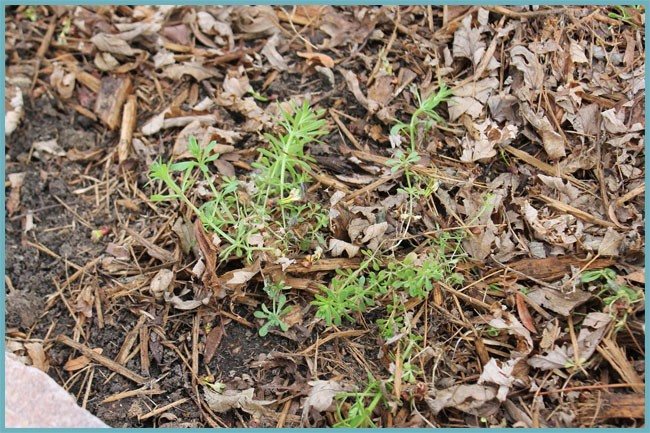

Feed the plant in the spring before flowering
Plants can be fed with nitrogen fertilizers at the time of the growth of the green mass. Before flowering, complex fertilizers are applied to the alissum soil. Perennial species, unlike annual ones, do not require too frequent feeding. They will need just one procedure done in the spring season.
Alyssum ampelous: growing and care
The truss variety can be grown both in nurseries and as wonderful hanging decorations. Most often, a small and abundantly flowering plant is used in border aesthetics, placed in small pots on balconies or hanging flowerpots in personal plots.


Care and cultivation does not differ from other varieties, so the scheme is identical for all categories. If the lobular representative is planned to be grown as a pot crop, sowing can be done directly in pots. After germination, the seedlings are thinned out or some of them are dived into separate containers.
Description of alissum
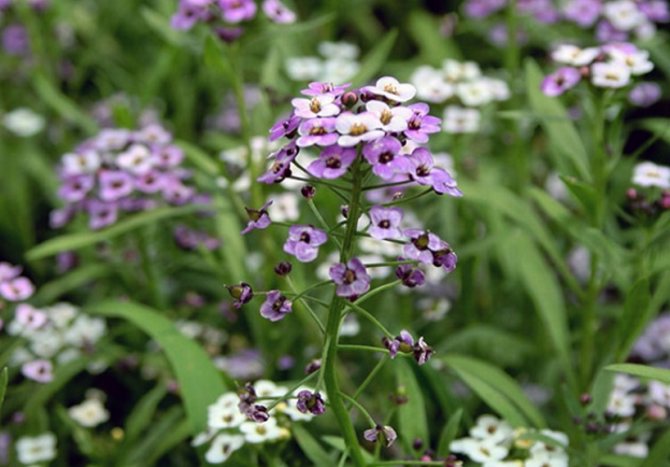

In garden floriculture, both perennial and annual species are used. In appearance, they practically do not differ. Annual alissum is grown more often, since perennial bushes tend to lignify and bare at the bottom of the bush and therefore require constant pruning. Annual varieties can be dispensed with.
Alyssum is a creeping plant that can reach a height of 40 cm. Thin stems are covered with small leaves, on which there is a slight pubescence, which gives the foliage a gray-green color. Flower brushes are formed at the ends of the shoots, their diameter can reach 4-5 cm.The flowers themselves are very small, their diameter does not exceed 0.5 cm.
Another feature of alyssum flowers is a strong sweet smell, which is especially felt in hot sunny weather. Therefore, this plant is often included in a mixture of aromatic annuals.
Use in landscape design
Lobularia are often used as a decoration for rockeries, since against the background of other representatives of the flora, they compare favorably with their ability to perfectly fill the space of open areas, adjacent to boulders and small stones, covering their surface with a bright plant cloud. For a competent design, one should be guided by the choice of varieties that harmoniously complement each other in tonality, using no more than 3 shades in the nursery. For example:
- purple, white and blue;
- pink, white and crimson.
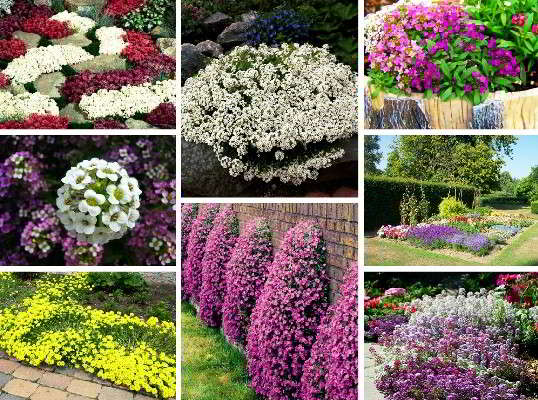

Combination with other plants
Lobularia are versatile representatives of the flora, since they are wonderful decorations both in single plantings and in the company with a vegetable neighborhood. For example:
- they will be the perfect edging for lilies or roses, carnations or phlox;
- go well with tulips and irises;
- grow harmoniously with petunia and begonia.
Bright lobularia wonderfully coexist with decorative deciduous plants and conifers like yew or juniper species.
Types of alissum
Today, the cruciferous family, one of which is alyssum, has more than 150 species. The most extensive species diversity of alyssum is represented in European, Asian and North African countries.
In landscape design, rock alyssum is most often used, which grows up to 20 cm in height.
The native land of the plant is the Mediterranean region. It was there that the flower first began to be used for landscaping. Alyssum is rocky and is still used to create borders around lawns, garden paths and flower beds.
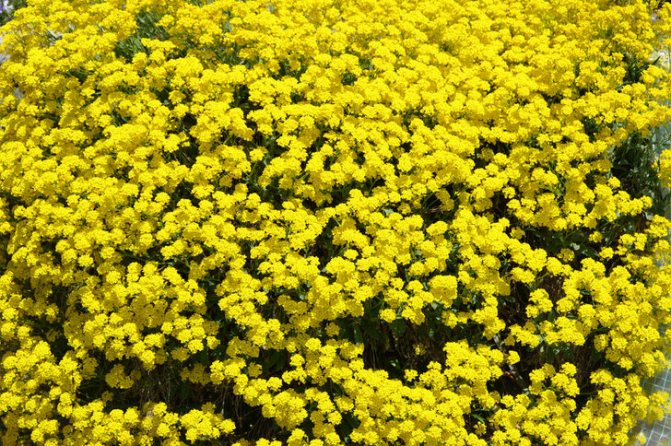

Alyssum rocky yellow will perfectly fit into any landscape composition.
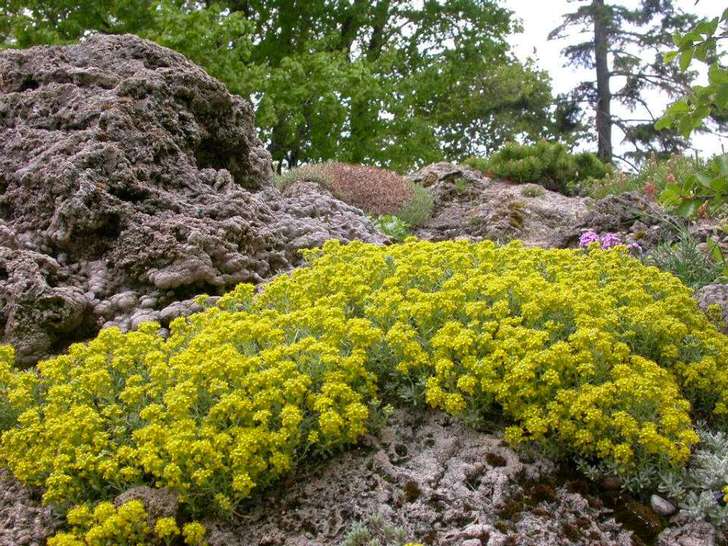

Alyssum rock flowers grow on a large block of stones.
Plants of this species prefer moderately moist soil, well warmed by the sun. In the case of a competent selection of the planting site, the plant blooms profusely and for a long time. The flowers of alyssum rock have a racemose shape and are located so densely that they are able to completely cover various defects of the territory: cracks in fences, stumps, pits or ditches.
Another member of the family is the sea alyssum. It is widespread in warm coastal regions: along the coast of the Bay of Biscay, in the Azores and Canary Islands. The plant prefers a temperate climate and sandy soils. Cultural sea alyssum, represented by breeders with a wide variety of varieties, can be grown in cultivated and fertilized fields and plots. The main condition here will be the presence of limestone soil. Sea alyssum is very undemanding to care for, but regular spring pruning of old shoots will significantly increase the abundance of flowering.
Perfectly combined in a flowerbed with Alyssum: Delphinum, Jasmine, Lupine.
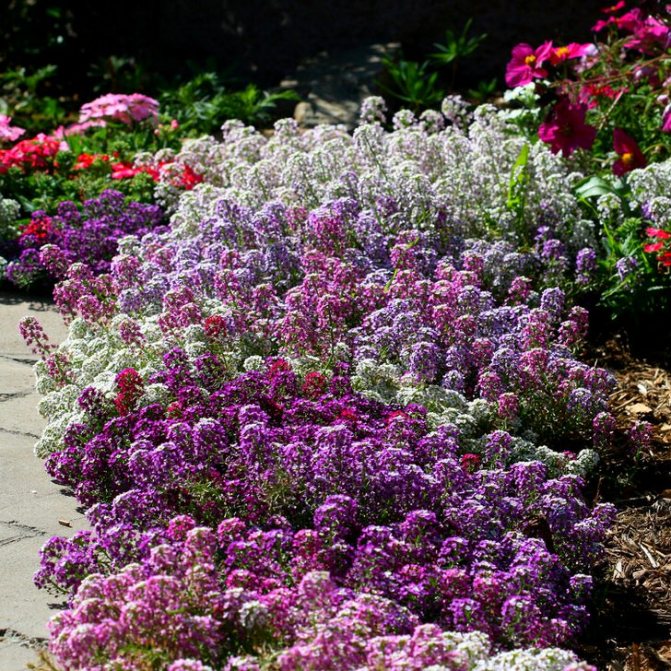

Delicate purple flowers of alyssum marine gracefully border the garden area for relaxation.
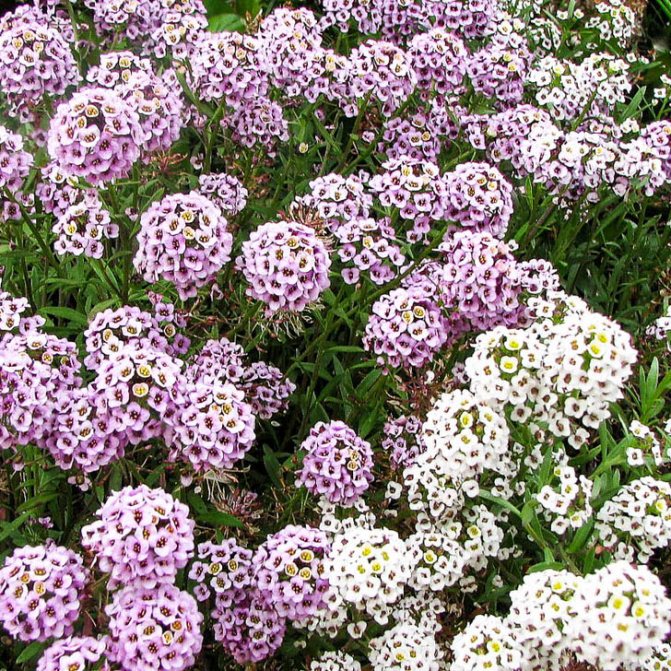

Rounded inflorescences of sea alyssum at the doorstep of the house will delight its owner and his guests.
Alyssum ampelous, used to decorate terraces and gazebos as a pot culture, has a high decorative effect. Alyssum Esther Bonnet, grown in pots, flowerpots and hanging baskets, has received wide recognition. The showy plant is a lush white ball studded with small fragrant flowers. To create a composition in a basket with a diameter of more than 35 cm, about 7-8 plants are required.
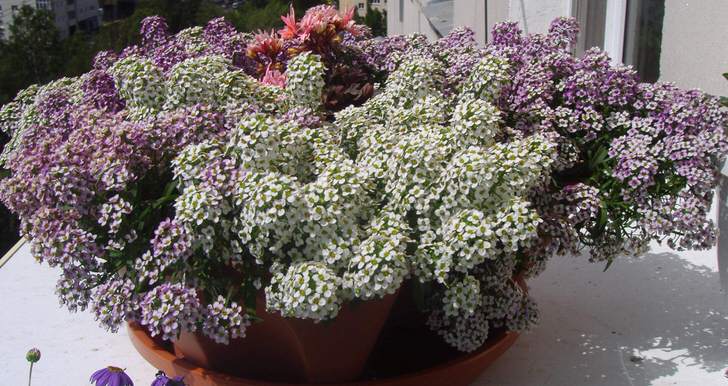

Multicolored alissum buds in large pots for garden decoration.
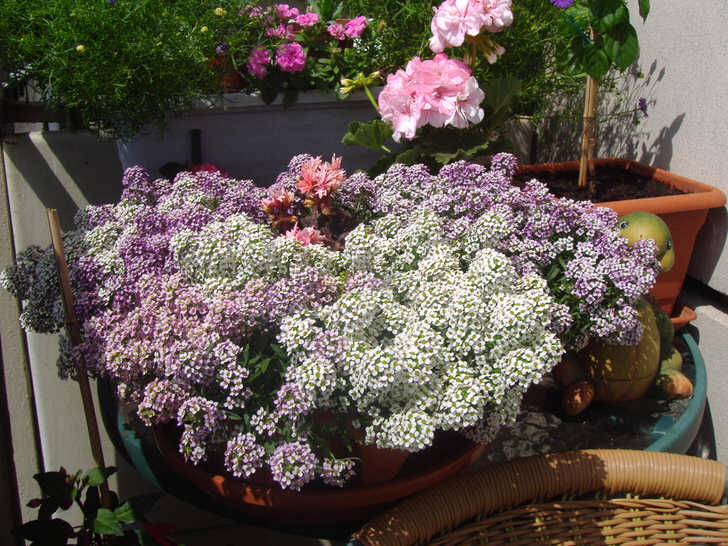

Snow-white alyssum flowers are favorably combined with delicate purple flowers.
Forum, reviews: what does the gardening experience tell about?
Novice and experienced gardeners alike are happy to announce the success and ease of growing charming annual crops. Most often, even perennials are cultivated during one season, since climatic conditions do not allow them to winter safely. But this fact does not upset flora lovers in any way, because it is not difficult to acquire new specimens.
Alyssum planting and care, various photos of beautiful plants together bring only the most pleasant chores and aesthetic pleasure, which will be confirmed by almost every lover of fragrant colors.
Growing difficulties
Bulbous flowers for the garden and indoor plants
Despite the ease of care, difficulties may arise in growing it:
- Alyssium does not bloom. The main reasons why alyssum does not bloom are plant diseases. It can be late blight and brown rot. A white coating begins to form on them. Diseases occur due to excessive pruning or high nitrogen fertilization. Diseased specimens are dug up, the roots are washed in a pink solution of potassium permanganate and planted in another place.
- Alyssium does not grow. The flower may not grow due to the presence of pests on it.The main pests are cruciferous fleas and cabbage moths. To combat them, it is necessary to treat the plant with special preparations. Suitable "Aktara", "Aktellik", "Fitoverm".
Alyssium is a beautiful plant that goes well with other flowers in the garden or in the flower bed. It can be combined with viola, roses, irises, tulips. It is easy to take care of it, so this flower should definitely pay attention to novice gardeners.
Testimonials
Elvira, 41 years old, Krasnodar: “I sow alyssum seeds in tablets. Seedlings appear on the 5th day. After 10-12 days, I plant the alissum seedlings in separate bowls. They are small, so I transplant several of them. I put the seedlings under the lamp. I water in moderation. In April I transfer it to the greenhouse. "
Anna, 48 years old, Togliatti: “Alyssum was grown by seedlings. After transplanting to a flower bed, a cruciferous flea ate all the bushes. They came to life by the end of August and blossomed. "
Natalya, 30 years old, Moscow region: “Soot varieties with white and lilac inflorescences. Until May, the seedlings are grove in the greenhouse, then I transplant them to the flower bed. Alyssum blooms all summer. It smells delicious. "
Short description
In spring, the rocky view will delight the beds with golden yellow flowers, from summer to autumn we will be delighted with the sea alyssum with white, pink or purple flowers. The flowers are small, but numerous, located on one stem, collected in the so-called bunches. Shoots with flowers reach a length of 30 cm, grow from a rosette of oblong grayish-green leaves.
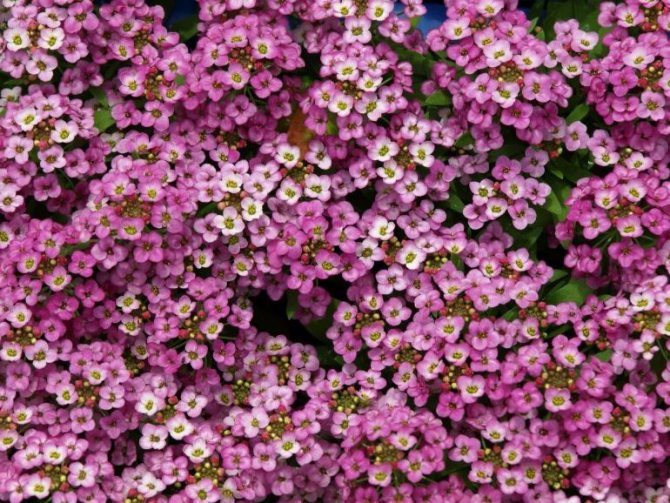

Combinations with other colors
In the garden, beetroot is harmoniously combined with flower plants. Large flowers of irises, peonies, lilies look advantageous against its background.
Heliotrope
Heliotrope loves the sun, blooms all summer, does not like tall neighbors. Low-growing varieties of alyssum serve as a good addition to it when decorating borders.
Turkish carnation
Carnation is a perennial plant that loves bright lighting, moderate watering. The color of the inflorescences is monochromatic or variegated. Harmonious compositions are obtained from Turkish carnation and alyssum.
Pelargonium
Pelargonium, like all varieties of alyssum, blooms all summer. Its bright green leaves and inflorescences look spectacular against the background of a snow-white, lilac or lilac carpet of a blooming groundcover.
Varieties
In nature, there are many varieties of alyssum, most of which are suitable for growing in Russia. However, gardeners cultivate only a few of them. Consider the most popular types of this perennial.
Rocky
The height of an adult plant is 30 centimeters. The branchy shoots of the shrub form a hemispherical shape, its diameter can reach 40 centimeters. The leaves, due to the presence of felt pubescence, retain their freshness even in the worst weather. They are painted in a cornflower blue shade.
Despite the fact that the small flowers form a dense brush, the inflorescences are quite short. In late spring, alyssum begins to bloom. This process takes about 40 days.
Among the most famous varieties of rocky alissum, the following are distinguished.
- "Golden Wave". The height of an adult perennial bush can be 20 centimeters. The inflorescences of such a beetroot are painted in a golden hue. Flowering occurs at the beginning of the summer season. The leaves, like many varieties of alyssum, are pubescent. They are colored silvery green. Caring for a plant presents almost no difficulties. This variety perfectly tolerates the dry season.
- "Aphrodite". The plant represents undersized bushes, the flowers of which are painted in dark red. Burachok begins to bloom in June. It is better to plant the flower in a slightly shaded place and observe moderate watering. The soil at the landing site should be enriched with useful components. From time to time, the plant needs feeding.
- "Plenum".The main difference between this alissum is its terry inflorescences, which have a golden hue.
Nautical
Such a perennial is often called marine lobularia. However, according to the official classification, this name is incorrect. The heat-loving sea alyssum bush can grow up to 35 centimeters in height. Creeping shoots form a lush bush. The leaves of the plant are oval in shape, they are painted in a rich green color. Flowering lasts throughout the season.
Popular varieties of sea alyssum.
- Violet Konigin. Lush inflorescences of an ampelous plant are painted in lilac color, suitable for growing in hanging pots.
- "Princess in Pöpl". This variety is also ampelous. Hanging shoots are a characteristic feature of the beetroot, so they are often grown in pots. If you cultivate a perennial in a flower bed, then it will look like a solid carpet. The inflorescences of such alyssum are colored purple.
- Tiny Tim. These bushes are completely covered with small white flowers. The variety is creeping, its maximum height is 8 centimeters. Due to these features, the perennial looks like sea foam.
Mountain alissum
This type of perennial plant perfectly tolerates low temperatures. The height of an adult bush is 20 centimeters. Borachka is characterized by creeping stems and pubescent leaves. The inflorescences of wild varieties are yellow. Cultivars have a more varied range of colors.
Alyssum breeding methods
The choice of reproduction and cultivation of the Alyssum flower directly depends only on you. It does not give root shoots. However, of course, the simplest and least energy-intensive way is to grow by seed.
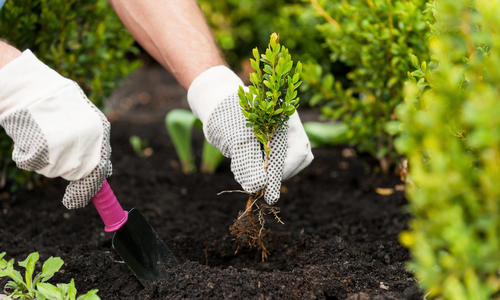

But we will certainly consider all possible options.
Seeds, as in many other cases, are purchased either in stores or use their own, left over after the flowering of the previous "harvest"
These seeds are quite unpretentious and have good germination, so planting them and achieving the desired result is not so difficult.
The seeds do not need to be deepened in the ground - this is one of the main features of planting. They are simply sown directly onto the ground over the entire surface.
From above, to a thickness of about 3 cm, either sand or garden soil is poured. But for better germination, experienced gardeners are advised to mix these 2 substances in equal proportions to obtain the so-called "substrate".
The planting site is recommended to be watered abundantly and covered with straw or other heat-retaining material.
It is very important to maintain humidity and optimal temperature, so the planting should be watered regularly and “warming measures” taken at night so that the seeds do not freeze.
2 weeks after the first shoots appear (and this will take about 7 to 15 days), they need to be thinned out so that about 15-30 cm of space remains between them (do not forget that the plant will have a rather big "hat" !)
Planting by cuttings
At that moment, when too long shoots appear, they need to be cut off. Then they are planted in a pot filled with a mixture of peat and sand, covered with something on top (usually glass or polyethylene) and provide the optimal amount of moisture, constantly watering the shoots.
Some gardeners plant shoots in the ground. In this case, you can cover them with glass jars or plastic bottles.
Layering planting
Planting Alyssum flowers by layering is still a better option, since in this case there is a high probability that the culture will survive, since it does not excommunicate from the "parent" flower.
The ideal time for this procedure is the growing season. Usually this is the middle of summer, when the so-called "heyday" occurs.
It is necessary to find young shoots on the plant, which, it seems, have not yet taken root, but are moving towards this.These parts must be pressed to the ground and sprinkled with moist earth, in this way the natural growth conditions of the flower are fully reproduced. Then it is necessary to carry out the mandatory procedures in a timely manner - watering, loosening, fertilizing.
Saplings are a fairly popular breeding method. If you also stopped at this option, then the recommendations for planting are as follows: 2-3 seedlings are placed in the ground, in a pre-formed "hole". After 30 cm, another 2-3 seedlings are planted.
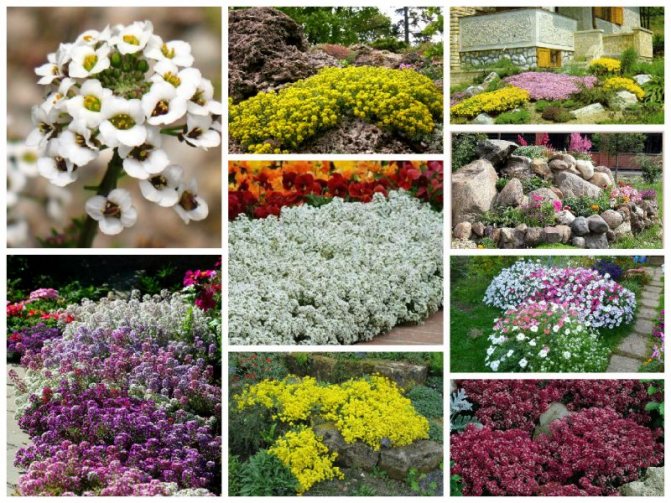

This pattern repeats exactly until you run out of material. The flower has the ability to grow, so all the space that you have free will soon be filled with beautiful leaves! On average, thanks to this method, you can get 11 plants per 1 m².
Seedling care
The procedure is usually carried out in early spring. Small boxes or plastic cups are filled with a nutrient medium mixed with lime. The seeds are poured evenly onto the surface, only slightly pressing them inward.
The seedlings are stored in a well-lit and cool place (temperature from 10 to 15 ° C), covered with polyethylene or glass. It is very important to ventilate the room in which the seedlings are located and to moisten the substrate in a timely manner.
If everything is done correctly, then in 7-8 days the first sprouts will appear. And after you see the first real leaves, you need to feed the substrate with complex fertilizer.
It is possible to transplant a seedling into open ground at a time when 2-3 large leaf plates have already formed on it.
Alyssum can be propagated in the following ways:
- cuttings;
- dividing the bush;
- seeds.
The first two methods mainly relate to perennials. In practice, growing alyssum from seeds is used - the most convenient method. The seeds have a rounded flattened shape and a diameter of no more than 1 mm.
Sowing seeds is carried out either directly into the ground or for seedlings.
Gardeners reviews
Alevtina, Naginsk
On a low flower bed, 1 meter high, "planted in the spring", then thinned to 15 cm between the plants along the edge. In the center were gladioli. It was like a white cloud, it smelled.
Ninash, Saint Petersburg
Alyssum Esther Bonnet from Biotech. Very beautiful, ampelous. The bloom is dense and fragrant. If you collect seeds later, it completely repeats the properties.
Growing features
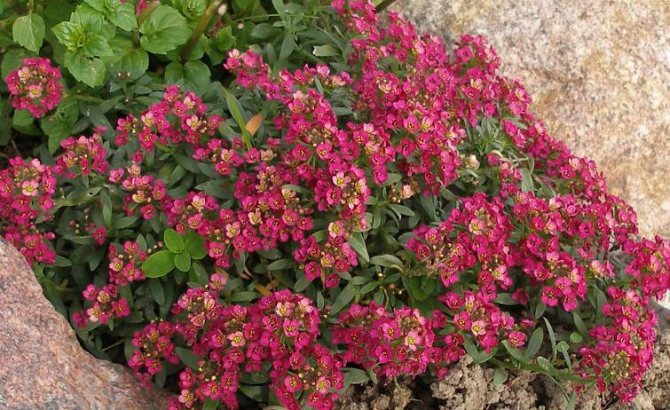

Infection with diseases and pests occurs when the growing conditions and care rules are not followed. Among insects, the cruciferous block, cabbage moth and white butterflies are dangerous. If signs of pest infestation are found, the planting should be treated with a systemic wide-acting insecticide, and the procedure should be repeated after 14 days. As a preventive measure, it is recommended to treat the flower garden with a weak solution of acetic acid (1 tbsp. L. Essence per 10 liters of water).
In areas with high humidity and improper watering, beetroot is often affected by fungal diseases (late blight, powdery mildew, root rot), viral infections are less common. If the plant has slowed down the growth rate, characteristic signs of infection on the leaves and stems have appeared, the flower garden should be treated in a timely manner with a copper-containing fungicide (1% solution of copper sulfate, 1% solution of Bordeaux liquid, Hom, Oxyhom and Ordan). Processing is carried out in two stages with an interval of 2 weeks.
Alyssum, or beetroot, is an unpretentious ornamental plant that, even with minimal care, can bloom profusely for almost the entire season. Suitable for creating voluminous ridges, planting in rock gardens and even hanging planters. When growing, you should choose the place wisely, try to maintain moderate soil moisture and carry out the formation on time.
Care in the garden from the moment of planting in the open ground until autumn
The cultivation and annual care of garden alyssum is very simple and consists in watering ornamental crops, regularly loosening the soil, periodically removing all weeds, as well as pruning and standard feeding.
How to care during growth and flowering
At the stage of active growth processes and the development of the aboveground part of the decorative culture, competent care should be provided. Watering is carried out with settled water when 40–45 mm of the upper soil layer dries out. Loosening is recommended after irrigation measures. Mulch allows for less watering.
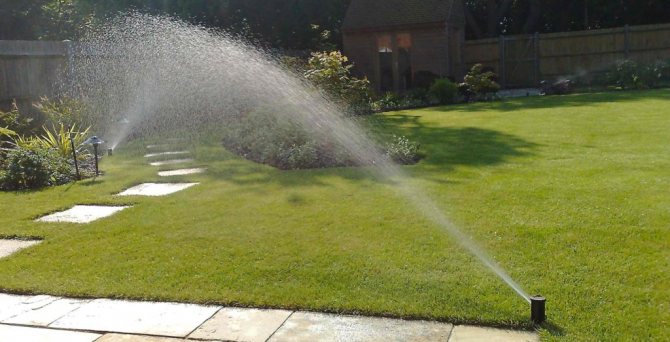

You can use an autowatering system
Top dressing is carried out at the stage of active growth of green mass by decorative culture. Perennial alissums are fed with nitrogen fertilizers of the Agricola-7 type and urea at the rate of a tablespoon of each product per bucket of settled clean water. Before mass flowering, the plant is fed with complex fertilizer. Annual varieties require more frequent feeding.
Full-fledged growth processes and abundant long flowering of alyssum require correct and timely pruning. In the spring, dried leaves, as well as diseased or weakened branches, are removed from perennials.
Recent Entries
Rose Petal Jam and Its 7 Health Benefits You Likely Didn't Know About What Fruit Are You According to the Zodiac Sign The 11 Best Grape Varieties That Will Help You Create Unique Homemade Wine
After the summer flowering, pruning is repeated, and all plant branches are shortened by 50–80 cm, which will stimulate the re-flowering of some Alyssum varieties.
Popular varieties
Among flower growers, varieties are popular, which are obtained on the basis of rock and sea alissum. Bushes have different sizes and colors of inflorescences.
Snow carpet
Spectacular white inflorescences form large (10 mm) flowers. The variety prefers sunny places, it can grow on a rocky slope.
Pink queen
Blooming low bushes (10-20 cm) form colorful rugs in delicate pink-purple hues. The variety is planted along paths, rocky slopes are decorated.
Wonderland
The flowers are small, carmine pink. The bushes are neat, about 10 cm high. The plant is grown in a pot culture, used to decorate borders.
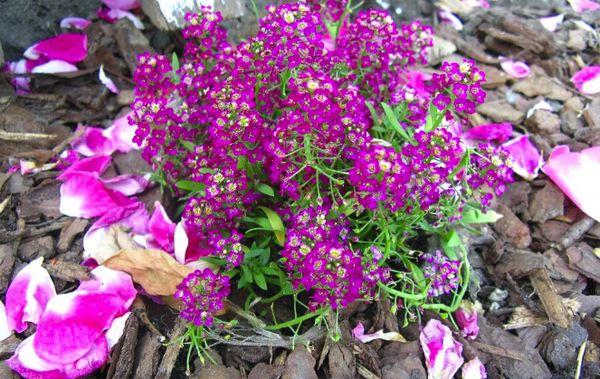

Gold placer
A creeping variety of alyssum. Rocky gardens are decorated with bright yellow inflorescences. Flowering bushes are spherical.
Magic circles
Shoots are grayish-green, 15 cm long. Inflorescences are light yellow, fragrant.
Tiny Tim
The length of the shoots does not exceed 8 cm. During flowering, dwarf bushes resemble sea foam. They are covered with numerous snow-white flowers.
Easter Bonnet Deep Rose
A variety belonging to the marine species of alyssum. The name translates to purple Easter hat. During prolonged flowering, the bushes are strewn with lush bright pink inflorescences.
See also
Descriptions and characteristics of the species and the best varieties of crocuses, which areRead
Princess in Purple
Ampel plant. The inflorescences are purple. When grown on a flat surface, the flowers form a continuous bright carpet. In a pots, the variety looks even more delicious. Long, flowered shoots resemble a waterfall.
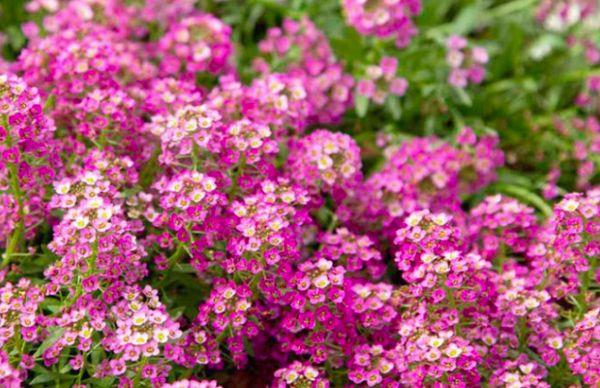

Violet Konigin
The cultivar was named the Purple Queen because of the color of the carpal inflorescences. Bushes are low (15 cm), neat, shaped like a ball.
Palette
The bushes are low, the length of the stems is 10 cm. The color of the flowers is very different: brown, crimson, yellow, red, white.
Pink rug
Shoots 12 cm long. There are many of them in the bush. During flowering, they form a solid purple carpet.
Big Jam
The flowers are large, white, lavender, purple or light lilac. The length of the stems is 35 cm.
Compactum
Alyssum is rocky.Bushes are low (18 cm), covered with bright yellow inflorescences.
Citrinum
Rocky Alyssum variety, pale yellow inflorescences.
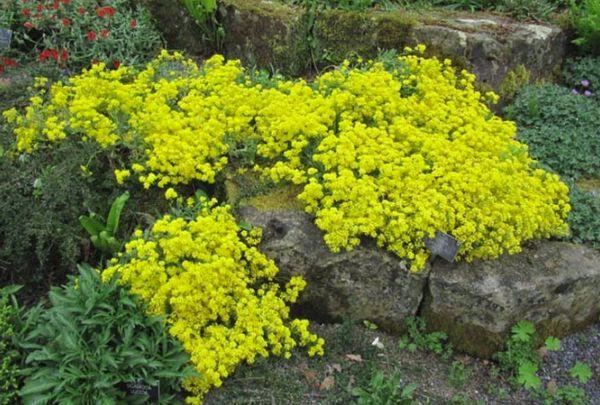

Fiore Rieno
A variety of rocky alissum, golden-yellow inflorescences.
Golden wave
Grown as a perennial flower culture. The first flowering occurs in the 2nd year after planting. Inflorescences are golden yellow in color. The length of the shoots is 25 cm, the diameter of the bush is 40 cm.
The plenum
Terry inflorescences, bright yellow.
Easter hat
This is a series. It includes early flowering low-growing (10-20 cm) varieties. The range of colors is wide. The colors are saturated. Inflorescences are large, retaining decorative effect for a long time.
Giga
A fast-growing variety with highly branching stems and large inflorescences.
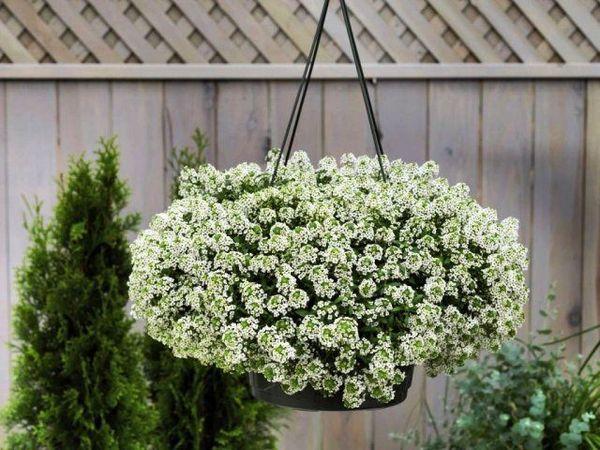

Aphrodite
Variety of alissum rocky. Prefers openwork partial shade in the middle of the day, fertile soil, moderate watering. Bushes are low, purple inflorescences. For abundant and long-term flowering, they are fed with complex fertilizers.
Growing seedlings
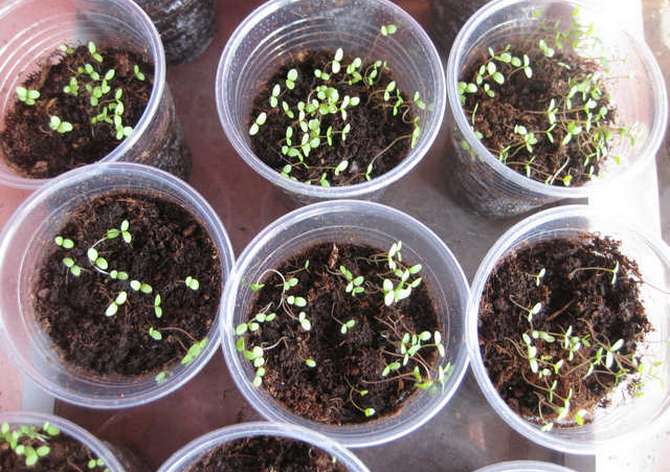

Planting seeds for seedlings allows you to achieve early flowering, which is especially important in the northern regions. Seeds are sown at home starting in March. For work, you need to prepare a seedling box and soil for planting. It is best to buy a seedling substrate in a store or create it yourself (mix garden soil, river sand and peat in a 2: 1: 1 ratio).
Seeds are scattered on the surface of the soil without pretreatment, a thin layer of sand 1-2 cm thick can be sprinkled on top. After that, the box with seedlings should be covered with foil or glass, put in a well-lit place.
Description
Alyssum has other names. Many flower growers know it as a little beetroot or stonemason. It is a genus of ground cover plants of the Cruciferous family. It includes at least 100 species. There are frost-resistant perennial varieties and more thermophilic varieties that are grown as annuals.
The plant is undersized, ground cover, the length of branched shoots is 10-40 cm. The root is fibrous. The lower part of the branches lignifies over time. Young shoots are covered with light fluff. Leaves are alternate, obovate, no petioles.
The bottom of the leaf plates is covered with gray or silvery villi. Inflorescences are formed at the end of May at the tops of the shoots. The flower cup is formed by 4 petals. The color can be very different. In culture, alissum is:
- white;
- pink;
- lilac;
- yellow;
- purple;
- purple.
The flowering period covers the whole summer. The fragrant flower attracts bees to the garden. By the end of summer, seed bolls are formed in place of pollinated flowers. The seeds are brown, small. Annual species are distinguished by longer flowering.
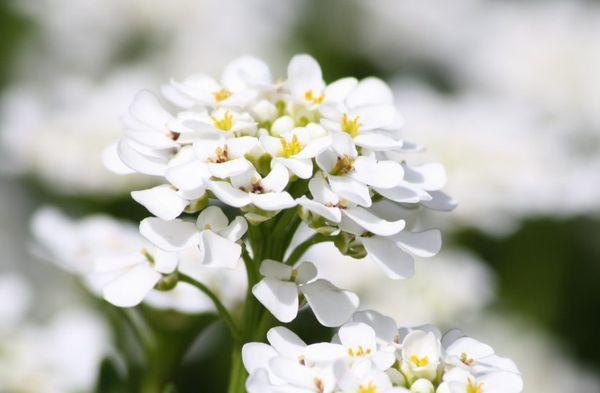

How to plant?
It is recommended to plant alissum only in fertile, slightly alkaline soil. A neutral soil is also suitable. It is advisable to add organic fertilizer to the planting hole in advance. This place should be located in a well-lit area. Do not allow stagnation of water in the soil.
When the soil is fully warmed up, and the possibility of frost is excluded, you can sow planting material. This process usually takes place in late spring. You can also sow seeds in late fall. Thus, they will undergo natural stratification, which will further affect the plant's endurance. In this case, the first shoots are observed in the spring.
The seeds are buried about half a centimeter in the ground. So the sprouts will have enough strength to break through a small layer of soil. Next, the sowing must be watered and covered with foil or glass. The greenhouse will promote faster seedling growth. You can not thicken the planting, as this can provoke the appearance of fungus. The seeds are placed at a distance of 20 centimeters from each other. After the first shoots, thinning can be done, if necessary. The perennial blooms within a month and a half after numerous shoots.
Planting material for seedlings is sown in the second half of March.The soil for sowing should be saturated with nutrients, slightly acidic. Usually, this method of breeding beetroot is needed in order to get early flowering; it is often used in regions with insufficiently favorable climatic conditions.
How to care for a plant?
Beetroot flowers love light. Therefore, the more sunlight arrives, the more and brighter they will bloom. The shade of flowers changes by two tones when growing conditions change.
Watering plants
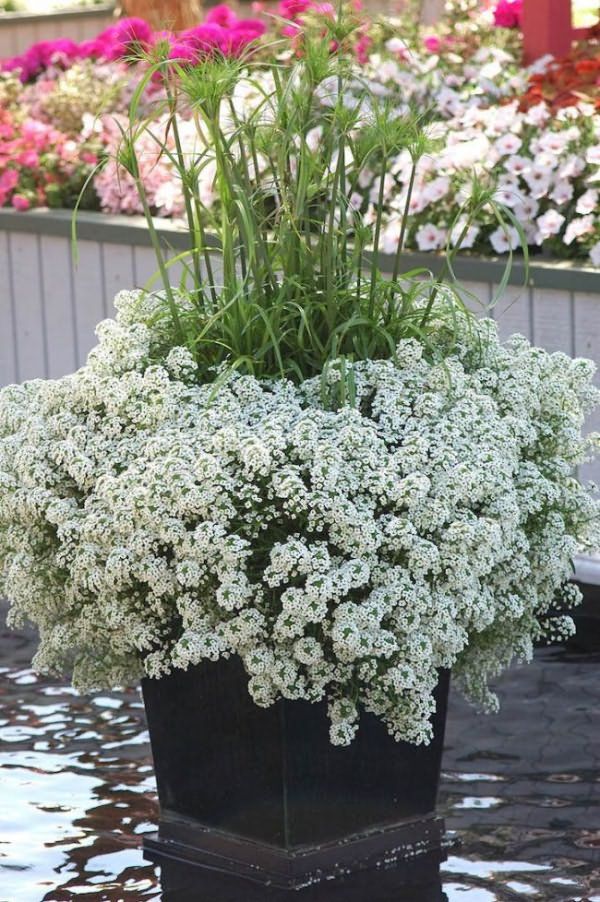

Considering the variety, soil moisture, temperature and air humidity, growers water the flowers. Alyssum annual needs regular and frequent watering, and perennial plant species thrive under normal precipitation. In the case when there has been no rain for a long time, you need to carefully monitor the soil moisture. Dig carefully three centimeters into the soil. If the ground is too dry, then it is necessary to take care of watering the flowers. When watering, it is important to monitor how the water is absorbed. If it lingers, the plant may rot and die. It is recommended to water the beetroot flowers early in the morning or in the evening after sunset.
Using
A groundcover flowering plant is used to create expressive compositions. A dense blooming carpet of white, yellow, lilac color serves as a background for taller ornamental plants.
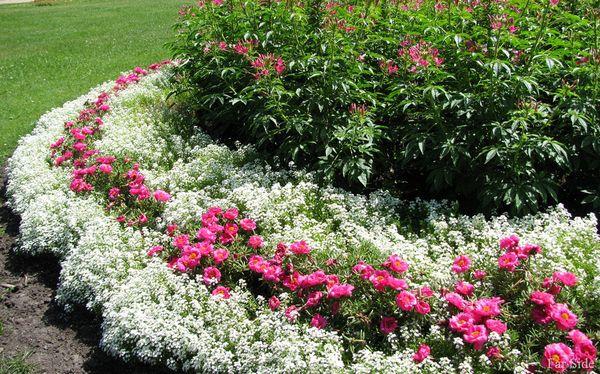

Landscape design
Easy maintenance and long lasting flowering are qualities that gardeners appreciate. Alyssum is often used to create backgrounds.
Alpine slides
For alpine slides, perennial varieties of mountain, rocky, and prickly alissum are selected. Medium-sized varieties with a height of 12-25 cm are suitable.
Stony areas
Perennial varieties are planted. The groundcover goes well with large boulders and small pebbles. Against the background of silvery foliage, the texture of the stones is fully revealed.
Mixborders
With the help of undersized species, they create a dense texture that resembles a carpet. To create ornaments, varieties with inflorescences of different shades are used. Mixborders decorated in yellow are especially expressive.
Garden walls
Ampel grades are used to design support walls. The flowering plant gives the ensemble a natural, noble look. The silvery-green shoots turn an ordinary wall into a unique object.
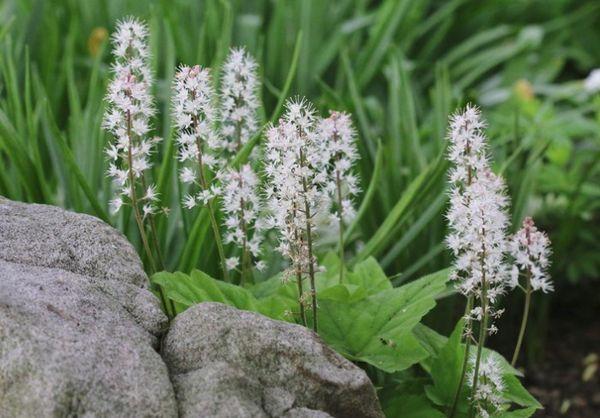

Flower arrangements
The variety of colors makes it easy to create harmonious flower arrangements. The inflorescences of the ground cover plant are well set off by bushes of roses, dahlias, phlox, lilies. In containers, it goes well with zoned pelargonium. On borders and flower beds, alissum is planted next to marigolds, snapdragons.
Smell
The honey aroma of inflorescences attracts bees, wasps, bumblebees. They pollinate fruit and berry crops, this increases the yield of the garden. Varieties with white inflorescences have a stronger smell.
Healing properties
Burachok has diaphoretic, diuretic and analgesic properties. Inflorescences are used for constipation. It contains organic acids and flavonoids. Drink infusion at high temperature:
- boiling water - 250 ml;
- dry, crushed alissum inflorescences - 1 tsp.
What problems do gardeners have with growing
Alyssum, very well known in decorative floriculture, is widely used in landscape design. Annual species are characterized by a longer flowering period, while perennial species are characterized by good resistance to low-temperature conditions. Ornamental culture is actively used in landscaping in the Mediterranean region, but it is well adapted for cultivation in the middle zone of our country.
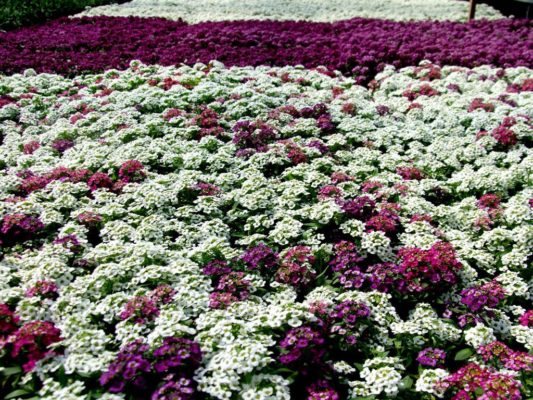

In areas with warm climatic conditions, alissum is grown as a perennial, blooming for a very long time - until late autumn
Alyssum in a tub or garden flowerpot is a frost-resistant summer and autumn flowering perennial, easy to care for.
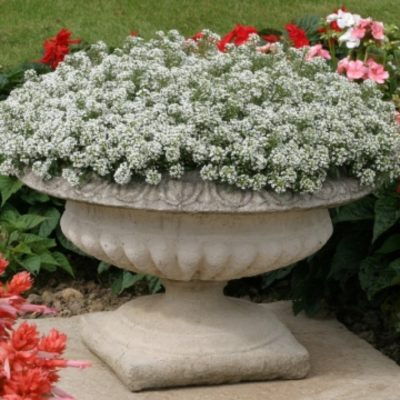

Alyssum is perfect for use in home gardening, has many flowers and an elegant, very delicate aroma
Fans of creating flower arrangements on the loggia very often use such a decorative culture as a beautiful and unpretentious border design for other plants.
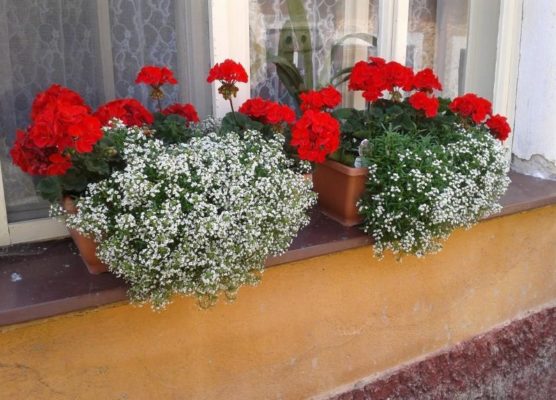

Alyssum is actively grown on the balcony
Planting an ornamental crop in a harsh northern climate is carried out only by seedling with sowing of seed in early February. In regions with warm weather conditions, an abundant flowering plant can develop over many years, while it blooms almost constantly.
Alyssum belongs to ornamental crops that are perfect for growing even by inexperienced and novice growers. Some possible problems:
- ornamental culture does not bloom abundantly enough - violations in the regime of fertilizing or watering, low level of sun illumination;
- the aboveground part of the plant turns yellow - low aeration of the soil, lack of sufficient irrigation measures;
- a garden flower grows poorly or withers - root decay as a result of waterlogging, improper feeding regime.
Due to its unpretentiousness, problems with such a plant occur quite rarely, but only under the condition of strict adherence to the rules of care.
Alyssum is susceptible to certain diseases and pests. To choose the correct and most effective scheme of control and treatment, one should correctly determine the type of damaging factor.
Sowing dates
The time when to plant alyssum when grown from seeds is selected taking into account the following factors:
- seed germination is observed within a week after sowing;
- it takes about two months before the first flowers appear from the moment of germination;
- a favorable temperature for the development of a plant and the formation of numerous flower buds is considered to be a temperature of at least 15-18 ° C, but mature specimens can withstand even slight frosts.
- In the harsh conditions of the northern climate, it makes sense to plant only in seedlings with sowing in early March. In Siberia, seeds are sown in the ground in early May. In this case, alyssum will bloom in July. To ensure early flowering, flowering seedlings are planted in open ground, in this case it is recommended to sow seeds in March.
- In the regions of the middle lane, sowing seeds is recommended directly into open ground, as soon as the threat of severe prolonged frosts disappears. The seedling method is used here if you want to form a flower bed with certain flowering times for each plant that makes up it.
- In an area with a warm climate, an abundantly flowering plant develops throughout the year and even for several years. It is planted at the onset of stable heat, around the end of April.
The lunar calendar gives recommendations based on long-term observations of the following indicators:
- phases of the moon (days when the moon is in the first and second quarters of the lunar cycle, that is, in the period between the new moon and the full moon are favorable for the development of the aboveground part of plants);
- the position of the moon relative to the earth, that is, through which of the zodiacal constellations the moon passes at the current moment.
Sowing seeds of alissum is done
- in open ground in late autumn before winter;
- in open ground in the spring;
- in a container with soil for growing seedlings.
Sowing before winter
Sowing before winter is recommended in regions where there is no severe frost. In this case, the seeds undergo natural stratification, seedlings appear early, and flowering begins at the end of May. The time for sowing is chosen before the snow falls, the soil temperature should be close to zero.
- Prepare the loosened soil, make shallow furrows about 1 cm.
- Spread the seeds out gently at 10–20 cm intervals; tweezers or a toothpick can be used if necessary.
- Sprinkle with light earth with a layer of no more than 2 mm.
Alyssum seeds are not very large, so you can use scrap materials for planting
Alyssum seeds have almost one hundred percent germination for three years. They do not need stratification before sowing. However, this procedure contributes to the accelerated appearance of healthy seedlings. For small seeds, stratification is performed as follows:
- Soak the seeds for 24 hours in a wet napkin.
- Put them in the refrigerator for a few days, where the temperature is 2–5 ° C.
- Start sowing.
Spring sowing
Sowing should be carried out when the ground warms up to a temperature of 10-15 ° C, and the threat of frost will no longer exist, at the end of April - May. Plants will bloom in July.
- Dig, level and moisten the ground.
- Pour or spread the seeds, observing an interval of at least 10 cm.
- Press the seeds lightly into the ground.
The sprouts will appear in about a week.
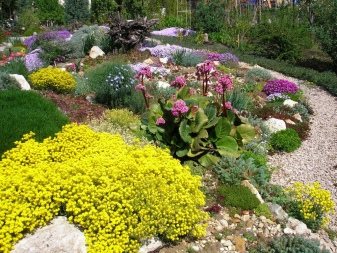

For growing alyssum seedlings from seeds, sowing is carried out in March. The plant is undemanding to the ground. If the soil is dense, it is recommended to add some river sand to it.
- Prepare a container with soil and moisten it.
- Spread the seeds on the surface, observing an interval of about 5 cm, and press lightly into the substrate. It is not necessary to sprinkle on top, as the seeds germinate in the light.
- Cover the container with glass or transparent foil. Place in a well-lit place.
- After the emergence of seedlings, remove the shelter.
Plant varieties
Interesting varieties of Alyssum combine into the following large plant species:
- Sea Alyssum blooms for one season, but for a very long time - with different colors: there are white, pink, purple, lilac shades of flowers. Marine Alyssum is very spring until the first cold nights. This type of rich flowers grows rapidly, forming a carpet of multi-colored inflorescences. The next year, the plant can germinate on its own, accidentally falling to the ground after flowering;
- Rock Alyssum is considered a perennial plant that has yellow flowers. The plant is resistant to drought, adorns alpine slides. Blooms from spring to early July. If you prune in the summer, leaving only 10 centimeters of shoots, the flowers can bloom again. In the winter season, perennials are covered or covered with snow;
- Alyssum Gmelin is a frost-resistant perennial plant. It grows 20 centimeters high. It has grayish downy foliage and lemon-colored flowers. Blooms from April to late June.
Healing properties
In folk medicine, the plant is prized for its medicinal properties. The infusion of the plant is used as a diuretic and laxative. It is useful to drink when bitten by a rabid dog.
If you wipe your face with infusion from the inflorescences of the plant, age spots and freckles will disappear.
During colds, a decoction from the plant helps relieve fever.
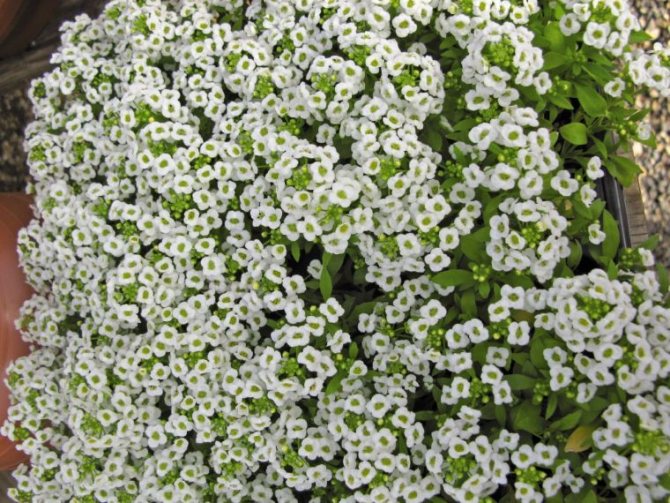

How and when to harvest your seeds
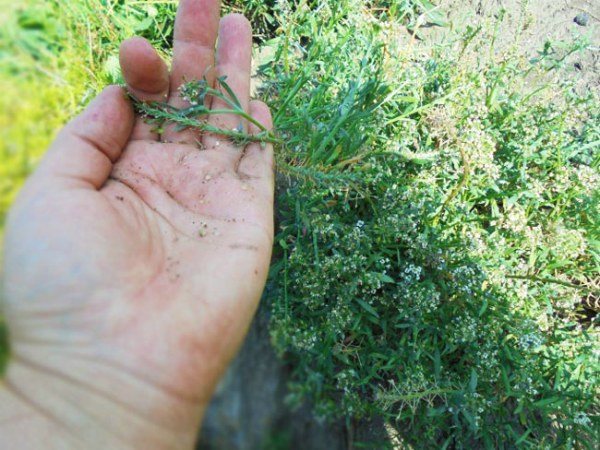

Alyssum seeds are very small and inconvenient to collect. However, if you follow the recommendations, the collection will be successful:
- The best time to collect seeds is at the end of September.
- A windless day is needed so that the seeds do not scatter, and dry.
- The scourge of the flower is carefully lifted, and a canvas or film is spread under them.
- The inflorescences are rubbed with hands, all the contents are poured onto a substrate.
- The whole mixture is dried, sieved to separate the seeds from the husks, and put into a canvas bag.
Diseases and pests
The plant is prone to being affected by certain diseases. Alyssum is seriously damaged by fungal infections such as late blight and powdery mildew. The development of such diseases is possible with waterlogged soil. In this case, it is worth trying to treat the plantings with fungicides.Bordeaux mixture will help get rid of powdery mildew. In this case, the affected processes are removed.
As for pests, the cabbage flea, or leaf beetle, is the most dangerous for alyssum. If found, the flower is treated with water with the addition of vinegar essence, or garlic water.
Caterpillars can also cause serious harm to the beetroot. Noticing a pest, you need to resort to processing the bushes with a strong chamomile infusion. This procedure is also used to prevent the invasion of other insects. Physical methods of struggle are also practiced - this is timely weeding, collection of caterpillars and eggs.
Alyssum is a plant that bees love, so you shouldn't get too carried away with chemicals.
Choice of place and conditions of detention
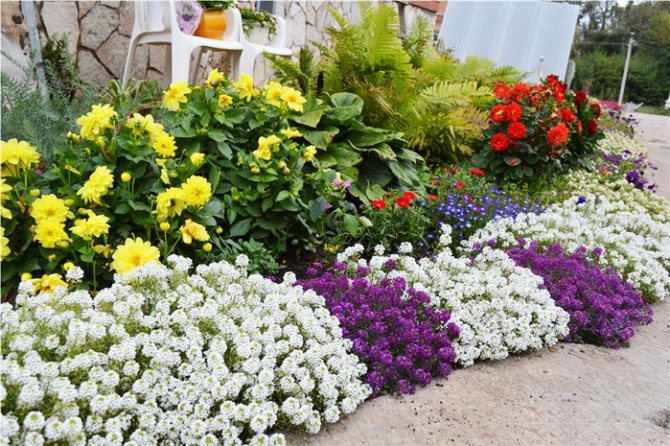

Alyssum is an unpretentious plant that can grow in one place for a long time without the need for transplanting. In order for the flower not only to fit into the landscape design, but also to develop comfortably, it is important to choose the right place. In comfortable conditions, the flower practically does not need care, it grows quickly, and demonstrates abundant flowering.
Lighting and location
To grow alissum, you should choose a well-lit area where there is a long daylight hours. It is best to plant the plant on the east or west side to reduce exposure to direct sunlight, which can cause leaf burns.
Alyssum perennial can grow in partial shade conditions, but it is possible to change the saturation of the color of the petals and their shape. Small hills are suitable for planting, for example, rock gardens. The flower looks especially decorative in rabatkas, in multi-species flower beds. Combines with low-growing perennials, ornamental flowering shrubs. Ampel varieties can also be grown in a hanging planter.
Temperature
Almost all cultivated varieties of beetroot are frost-resistant, retain the decorative effect of leaves under a layer of snow. The plant can be grown in regions with unfavorable climates, cold summers, flowering is possible in a wide temperature range from 12 to 25 ° C. However, seedlings are sensitive to temperature conditions, seedlings appear and develop only in warm conditions not lower than 15оС.
Air and humidity
Due to the low altitude and strong immunity, drafts, strong winds do not threaten the health of flowers. Therefore, they can be grown on hills without any support, shelter.
Maintaining moderate moisture is a key factor in caring for the beetroot. In conditions of increased dryness of the soil, the plant sheds flowers, lags behind in development. With an excess of moisture, there is a risk of rotting of the root system, shoots and even death of flowers. Watering should be done carefully, only in the absence of precipitation for a long time.
Priming
The plant can be grown on any substrate. Alyssum feels better when planting in light, well-fertilized and aerated substrates with a neutral or slightly alkaline reaction.
Acidic soil, as well as lowland and swampy areas with an acidic pH level, are not suitable for planting. It is advisable to thoroughly dig up the substrate before planting, and then add drainage and fine river sand to enhance aeration. In addition, it is not recommended to plant beetroot in areas where root crops grew before, which greatly impoverish the soil.
When to plant
The choice of planting time depends on the climate in the region, the condition of the soil and the method of cultivation. In open ground, alissum seeds can be planted from the beginning of May in warm regions, not earlier than the beginning of June in the northern regions of Russia. Planting is also permissible in winter after harvesting, but it is advisable to have time to carry out the procedure before the first night frosts.
Sowing for seedlings is carried out in early May, seedlings develop rapidly, so by the beginning of summer they are ready for picking.Seedlings can be transplanted to a permanent place, starting from the second half of May; in the south, picking can be carried out 1-2 weeks earlier.
Plant propagation
You can get new specimens in 2 ways: by seed propagation or by cuttings.
- Reproduction of alissum seeds - The easiest way. You just need to embed the seeds in the soil to a depth of 1.5 cm and wait for the shoots. When the seedlings start to grow, the plantings need to be thinned out in order to provide the plants with sufficient nutrition and proper care in the future.
- Cuttings... Less common, but also a good way to expand your collection. Over time, the bushes grow and become spreading. The plant becomes unattractive and needs to be renewed. You can cut the cuttings and put them in water, plant them in a pot, or put a mound of soil on a lignified stem. In order for the lateral processes to root faster, the first time should be watered abundantly. Closer to autumn, the rooted bushes should be dug up and planted in a permanent place. The old plant should be thrown away without regret to make room for new plantings.
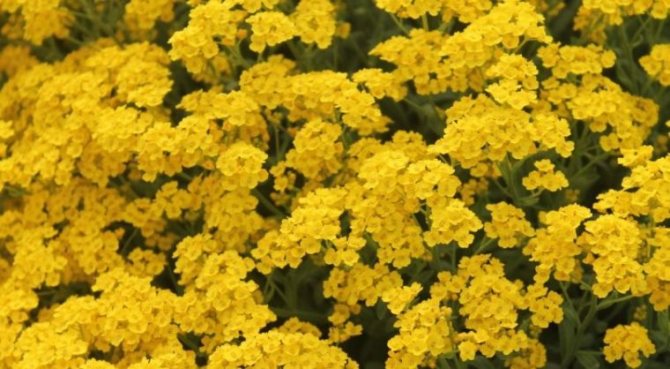

What colors are combined with alyssum in a flower bed
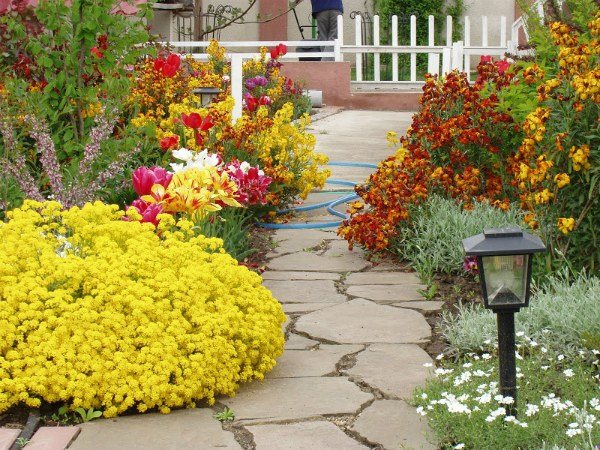

Increases the popularity of Alyssum for his sociability. It looks great in a variety of compositions. In flower beds, the culture is planted in the company of many perennials and annuals. Even ground cover and ampelous plants go well with it.


A flower is planted in mixborders, rockeries, Alyssum is often found in alpine slides. From tall varieties, they make up luxurious bouquets, combining them with tulips, irises, roses.
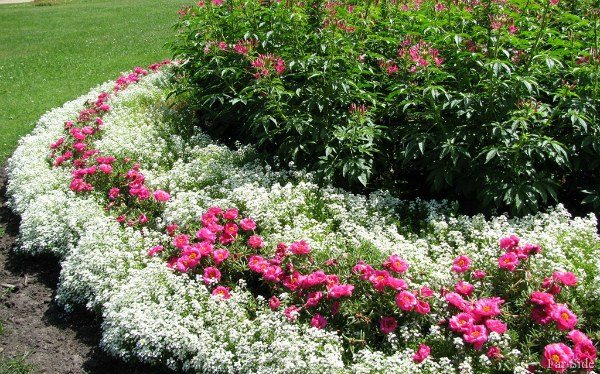

The plant is planted on stone slabs, on dry slopes. A very unusual contrast is given by violet Alyssum with pink phlox or dwarf irises. Alyssum and muscari will create a bright composition.
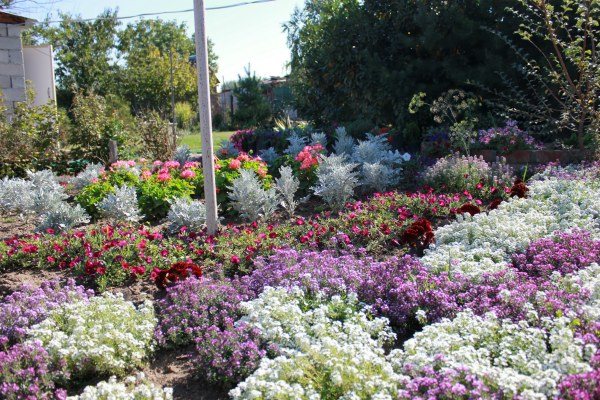

A good combination of Alyssum will be in compositions with heliotrope, Turkish carnation, pelargonium. Often, culture acts as a background plant, ideally emphasizing forget-me-nots, lilies, shaving, rezuha, purslane.
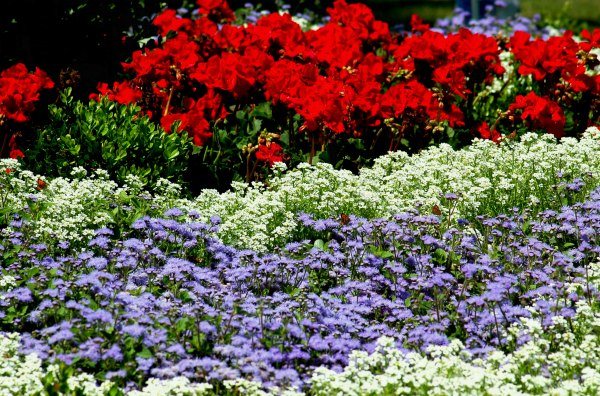

Purple Alyssum is in harmony with silvery cineraria, golden marigolds. White varieties look luxurious together with salvia, begonia, petunia.
Nuances
There are no special nuances in the cultivation of alissum. The ground cover bushes planted in a sunny corner of the garden bloom profusely all summer. In unfavorable weather conditions, plant development may stop. With a simple technique, they are reanimated, and flowering resumes.
See also
Rules for transplanting chrysanthemums in the fall to another place and terms for open groundRead
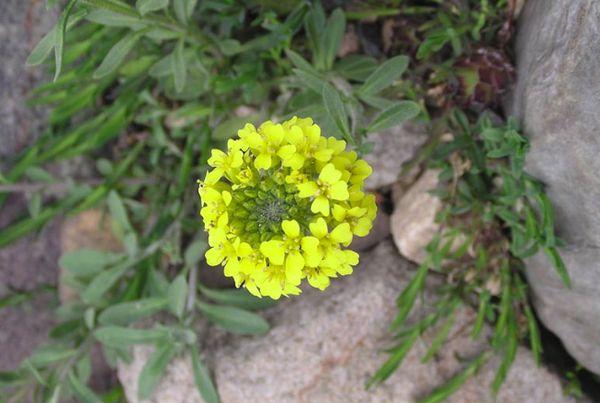

How to prolong flowering
Alyssum bushes, weakened by heat and drought, revive. First, watered, then cut out part of the shoots. Leave 5-6 pieces per bush. Prepare liquid top dressing:
- water - 10 l;
- urea - 1 tbsp. l .;
- Agricola-7 - 1 tbsp. l.
After restorative measures, the flowering of alyssum resumes, lasts until frost.
Features of winter planting
Perennial winter hardiness is average. To protect against frost, the alissum bushes are covered with fallen leaves for the winter. In winter, snow is thrown onto the flower bed.

